Trump’s One Big Beautiful Bill clears House and Senate
On the afternoon of July 4, President Donald Trump signed his “One Big Beautiful Bill” into law after it was cleared earlier in the week by both the House and Senate.

On the afternoon of July 4, President Donald Trump signed his “One Big Beautiful Bill” into law after it was cleared earlier in the week by both the House and Senate.
The 2025 U.S. Targhee Sheep Association National Show and Sale will take place July 17-19 in Miles City, Mont., welcoming breeders and Targhee enthusiasts from across the nation for three days full of top-quality sheep, networking and community. For more information and to view the show and sale catalog in its entirety, visit targheesheepus.com/show-sale
The deadline for the Wyoming Natural Resource Foundation’s Gary Beach Memorial Scholarship has been extended to Aug. 8. Those eligible include students enrolled at the University of Wyoming or in an accredited Wyoming community college degree program who are studying environment and natural resources, water resources, rangeland ecology and watershed management or a related field. For more information or to apply, visit wynaturalresourcefoundation.com/what-we-do/education-2/
The U.S. Department of Agriculture (USDA) is inviting growers and artisans from all 50 states to participate as a vendor at the Great American Farmers’ Market, set for Aug. 3-8 on the National Mall in Washington, D.C. Applications are due on July 13 and are available at managemymarket.com/vendorregister. aspx?orgID=606
The Bureau of Land Management Wyoming State Office announced an oil and gas lease sale scheduled for Sept. 16 to offer 37 oil and gas parcels totaling 45,178 acres in Wyoming. The BLM completed scoping on these parcels in March and held a public comment period which closed in May. A 30-day public protest period is now open until Aug. 7. For more information or to submit a protest, visit eplanning. blm.gov/eplanning-ui/project/2036327/570
At its core, this sweeping tax and spending package is an extension of Trump’s 2017 Tax Cuts and Jobs Act, which was set to sunset at the end of the year.
The bill also aims to
make significant cuts to healthcare and nutrition programs such as Medicaid and the Supplemental Nutrition Assistance Program (SNAP). However, other controversial provi-
sions initially appearing in the bill were left out, including one ordering the sale of public lands and another pausing state regulations on artificial intelligence.
National Interagency Fire Center predicts increased fire potential for Rocky Mountain Region throughout the month of July
As temperatures climb, fuels continue to dry out and afternoon thunderstorms start to roll in, wildfire officials warn July could bring increased potential for wildfire activity across the Rocky Mountain West.
According to the National Interagency Fire Center (NIFC) of Boise, Idaho, a combination of below-average spring precipitation, persistent drought conditions and a forecast for above-normal temperatures is setting the stage for a potentially volatile month, especially in Colorado and Wyoming.
Regional drought conditions
On July 1, NIFC issued the National Significant Wildland Fire Potential Outlook, which predicts fire activity across the U.S. for July through October using cumulative forecasts from the National Predictive Services Unit and 10 individual Geographic Area Predic-
tive Service units.
The report notes increased temperatures and limited precipitation west of the Continental Divide, with cooler temperatures, more precipitation and some improvements in drought conditions east of the Continental Divide.
Specifically, Colorado’s Western Slope and western Wyoming averaged five degrees Fahrenheit above normal. The western portion of the Rocky Mountain Region also saw scarce precipitation, with some areas receiving less than 10 percent of their normal June averages.

The National Association of County Agricultural Agents (NACAA) recently presented four recipients with the prestigious NACAA Hall of Fame (HOF) Award, one of which hailed from the Cowboy State.
According to NACAA, this award recognizes a member or lifetime member from each NACAA region for their Extension programming, state and national association activities and humanitarian efforts beyond the normal call of duty.
Each state can nominate one individual and must submit a 500-word summary and three letters of support.
This year, the 2025 Western Region NACAA HOF Award winner is Ron Cunningham of Lander.
Cunningham began working as an Extension agent with the University of Wyoming (UW) in 1977 and retired in 2015. During this time, he made a profound impact on the clientele of Fremont County, his colleagues and everyone around him.
Cunningham has been presented countless awards and honors over the years at every level – county, state and national.
As a lifetime member of NACAA and the Wyoming Association of County Agricultural Agents (WACAA), he was awarded the Career Achievement Award in 1981. He then went on to win the Distinguished Service Award in 1986 and was Wyoming’s Outstanding Educator of the Year in 2011.
Throughout his career, he was also recognized several times for his outstanding abilities, winning the Jim Dubree
On the other hand, June brought above normal precipitation for Colorado’s Front Range and the San Juan Mountains, as well as above normal rainfall scattered
Please see WILDFIRES on page 8

WSF announces participation in the National Great American Fair Initiative
The Wyoming State Fair (WSF) is honored to announce its participation in the National Great American Fair initiative, a national campaign launched by the U.S. Department of Agriculture to commemorate the 250th anniversary of the United States of America.
This effort invites all 50 state fairs in a year-long celebration of patriotism, community and the American way of life, starting in 2025 and building toward the nation’s official semiquincentennial in 2026.
“Fifty percent of the militia who launched the American Revolution had backgrounds in agriculture,” Gov. Mark Gordon noted. “I think this speaks to the character of this country and the importance of American agriculture and its critical place in the fabric of our country.”
“Designating the 2025 WSF as a Great American State Fair is a meaningful way to recognize the values and traditions which have long defined our state,” said Nick Neylon, a member of the Governor’s Semiquincentennial Task Force and a
For Kaidyn Kasun, exhibiting livestock is an exciting challenge, a learning experience and a family tradition.
A native of Wheatland, Kasun picks out her show projects locally and takes pride in exhibiting high-quality animals from the state of Wyoming across the nation. She has been showing livestock for nine years, carrying on a tradition passed down from her parents, Skye Dunlap and Levi Clark.
Kasun keeps a busy schedule with two market wethers, one breeding doe,
a breeding heifer and a market steer. She has been working with her 4-H and FFA goats and cattle for nearly a year and plans to show at Platte County Fair in late July before moving on to the Wyoming State Fair (WSF) Aug. 12-16.
A new venture
Kasun has been exhibiting cattle for nearly half of her life. Goats, however, are a more recent venture.
“I’m probably more confident in my skills showing beef than I am goats, but at

In the U.S., we’ve not had a war on our lands in modern times, so our main visuals of war come from the television and other media outlets.
One doesn’t realize all of the terror of war and impacts to the agricultural industry, similar to those felt by producers in the Ukraine who have been in a war for three years.
Ukraine is a huge exporter of agricultural products to Europe, Africa and Asia. It really is an agricultural bread basket, especially in the western part of the country.
A recent World Bank report detailed some of the costs of the war-ravaged country, which added up losses until December 2024, totaling $176.1 billion. This included $11.2 billion to the ag industry and $77.1 billion in stolen goods, lost crops, the forced slaughter of livestock and the destruction of fisheries.
Ukraine is still the world’s largest exporter of sunflower oil. Its ag exports bring in around 60 percent of the country’s revenue, so one can see supporting the ag industry is a government priority.
One of the largest problems, especially in the northeastern and eastern third of the country, are landmines buried on some 7.4 million hectares. One hectare equals about 2.5 acres.
In 2024, about 300,000 hectares of ag lands were demined to restore agriculture.
Ukraine has the most land mines of any country in the world, hands down. They have over 200 mechanical demining machines in use and over 5,000 demining specialists around the country, but still, hundreds of farmers have lost their lives to landmines.
Ag exports are vital to the country and so is the need for safe ports and access to the Black Sea. While Ukraine is trying hard to keep up its farm exports, the war has been hard on them.
Railways are playing a larger part now in transporting bulk shipment to markets, but this method is more expensive and complicated than using Black Sea ports.
Still, in 2024, Ukraine exported 57 percent of its ag exports to Europe, while countries in Asia – especially China – have reduced their imports. South America and Africa have increased their ag imports from Ukraine.
Corn has remained Ukraine’s top farm commodity export since the start of the war with about 77,032 thousand metric tons exported, versus 47,670 thousand metric tons for wheat. Sunflower oil was third by volume with 15,824 thousand metric tons.
Ukraine has caught on to soybeans, as their soybean production has doubled in size from 2021-24, while corn production has decreased by 18 million metric tons. But if demand grows, soybean acres will increase due to the lower cost of inputs compared to corn.
It is hard for us in America to imagine not being able to do our daily work. I can’t imagine being out gathering cattle or plowing a field and having to worry about going over a minefield or being bombed by rockets, planes, drones or artillery.
I have the utmost respect for the Ukrainians and hope this war stops soon. They surely have suffered enough.

By U.S. Secretary of Agriculture Brooke Rollins
Every year, wildfires destroy nearly 100 million trees across our national forests. These losses aren’t just an environmental tragedy. They are a national failure.
Every acre charred represents a missed opportunity to strengthen American industry, protect families and safeguard our drinking water. Yet, one-half of our forested acres are effectively off limits, impeding the actions and tools we use to protect them and ourselves.
We’ve watched this crisis unfold
for decades while Washington, D.C. stood by and allowed it to happen.
Not on President Donald Trump’s watch.
This is why, on June 23, I announced the rescission of the 2001 Roadless Rule.
Established with the stated goal of protecting remote forest areas from development, this Clinton-era rule has become a bureaucratic barrier to action, hamstringing U.S. Forest Service (USFS) officials.
Instead of protecting forests, it has
trapped them in a cycle of neglect and devastation. To date, we’ve seen more than eight million acres of roadless areas burn. To put this into perspective, the average acreage lost to wildfire each year has more than doubled since 2001.
For almost 25 years, road construction has been halted. Trees have not been thinned, and firefighters have been unable to reach fires in time to slow their spread.
Our forest supervisors know the
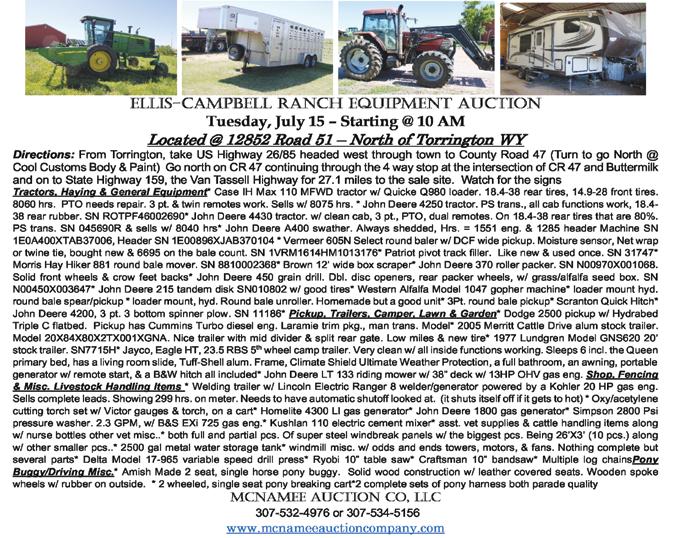



Thanks to the awareness of local anglers, the Wyoming Game and Fish Department (WGFD) has verified the presence of New Zealand mudsnails in Gelatt Lake and Wheatland Reservoir #3 near Laramie.
These confirmations mark the second and third waters in the region with this species, in addition to Alsop Lake which was detected in 2023.
Many aquatic invasive species, including New Zealand mudsnails, are transported by people on equipment and vehicles which have not been cleaned, drained or dried. They can burrow into the fabric of waders and wading boots, hide in mud stuck to trailer tires and camp out in any undrained water from all types of watercraft.
The WGFD appreciates all reports of suspected aquatic invasive species (AIS) and encourages everyone using Wyoming waters to clean, drain and dry their gear every time.
To learn more about AIS, efforts to stop the spread or how to get your watercraft inspected, visit wgfd.wyo.gov/ news-events or contact Nick Edwards at nick.edwards1@ wyo.gov with reports and questions concerning AIS in the Laramie Region.
On July 4, the Wyoming Game and Fish Department (WGFD) received a report of a black bear in north Sheridan. Personnel responded but the bear could not be located.
On the afternoon of July 5, WGFD managers received another report of a black bear. The bear was reported in the backyard of a residence which housed a flock of chickens and in an adjoining yard.
Responding personnel located and immobilized the bear. The bear was found to be a sub-adult female in good health. The bear was transported and released in a remote area of the Big Horn Mountains on the morning of July 6.
WGFD personnel have also responded to multiple bear conflicts in the Big Horn and Story area in recent weeks where garbage and bird feeders have been left unsecured.
Homeowners and businesses can help prevent potential conflicts by making attractants such as pet food, livestock and poultry feed and barbecue grills unavailable to bears and other wildlife.
Learn more about living and recreating in bear country at wgfd.wyo.gov/bear-wise-wyoming
Any sightings of a bear in residential or developed areas should be reported as soon as possible to the WGFD Regional Office at 307-672-7418 during regular business hours, to the Stop Poaching Hotline at 877-WGFD-TIP or to a local law enforcement agency.


The Four States Irrigation Council is hosting a two-day tour of central Nebraska’s water infrastructure, taking place Aug. 6-7. The itinerary was developed by the Central Nebraska Public Power and Irrigation District and will begin at Lake McConaughy before making its way to the Kearney area and back. Stops along the way will include historic dams, scenic reservoirs, progressive production plants and more.
Those interested in attending the Aug. 6-7 tour can register and find additional event details at 4-statesirrigation.org
The Four States Irrigation Council, established in 1952, hosts biennial summer tours throughout a four state region – Colorado, Kansas, Nebraska and Wyoming – as well as an annual meeting each winter.
Four States membership is open to anyone, and there are no annual dues or membership fees. To become a member, simply attend one of our events, or visit 4-states-irrigation.org and request to be added to the Four States mailing list.
The U.S. Department of Agriculture’s (USDA) Animal and Plant Health Inspection Service (APHIS) is updating its practices for reviewing petitions seeking a determination of nonregulated status for organisms altered or produced through genetic engineering (modified organisms) under 7 C.F.R. part 340. USDA is making these updates to ensure APHIS’s petition process aligns with recent developments related to the National Environmental Policy Act and APHIS’s authority in the Plant Protection Act (PPA).
Beginning July 9, when evaluating a petition seeking a determination of nonregulated status that meets the information requirements, APHIS will first determine whether a modified organism is subject to regulation under 7 C.F.R. part 340 and the plant pest provisions in the PPA.
If APHIS determines modified organism is unlikely to pose a greater plant pest risk relative to its comparator and, as such, is not a plant pest, APHIS will end its review and because it lacks jurisdiction over the modified organism, APHIS must issue a determination the modified organism is not subject to 7 C.F.R. part 340.
APHIS will continue to publish its draft reviews for petitions in the Federal Register for public review and comment before making a final determination about a modified organism’s regulatory status.
Recent federal legislation has eliminated funding for Wyoming’s Supplemental Nutrition Assistance Program-Education (SNAP-Ed) program, which currently provides nutrition education for families and individuals across the state. Per the One Big Beautiful Bill, changes will go into effect on Sept. 30.
SNAP-Ed is a federally-funded and state-administered program through the Department of Family Services (DFS) which empowers people with limited resources, helping them to develop skills to improve their health, stretch food dollars and increase food security.
In Wyoming, SNAP-Ed is provided by the University of Wyoming (UW) Extension’s Cent$ible Nutrition Program (CNP).
As the education arm of Wyoming’s Supplemental Nutrition Assistance Program – formerly known as food stamps – CNP teaches participants how to more effectively use the food resources available to them. Eliminating SNAP-Ed creates a critical gap in public health infrastructure in Wyoming and across the country.
Currently, CNP delivers free nutrition education programs in community settings, including public schools, UW Extension offices, Veteran programs, income-based housing and senior centers. CNP also works with community organizations to help put healthier choices within reach for people with limited resources.
Currently, CNP provides programming in every county in Wyoming and on the Wind River Indian Reservation. With the loss of SNAP-Ed funds, CNP will have to end programming, including its community engagement efforts, in most of Wyoming.
CNP will continue in a limited capacity through the Expanded Food and Nutrition Education Program (EFNEP) grant, focusing on nutrition education classes.
Gov. Mark Gordon issued a statement on July 8 supporting the Bureau of Land Management’s announcement of its intent to amend the Buffalo Resource Management Plan (RMP). This follows a 2024 announcement by the Biden administration of a “No Leasing” alternative in its RMP amendment had been selected.
Gordon states, “President Donald Trump and Secretary Doug Burgum have made good on their promises to take action to undo the damage the Biden administration did to the Powder River Basin. Early on, I spoke with both of them and explained Wyoming’s frustration the very industries that built our schools and powered our economy were being ignored and directly harmed by an ideologically motivated, anti-fossil fuel agenda.”
Gordon continues, “We know coal plays a critical role for Wyoming and in America’s efforts to achieve energy dominance. The restrictions in the previous Buffalo Coal RMP amendment were legally dubious, arbitrary and would result in less reliable energy. I support every effort to right this ship.”


The U.S. Department of Agriculture’s (USDA) Animal and Plant Health Inspection Service (APHIS) invites public comment on a petition to deregulate corn developed using genetic engineering to resist feeding damage caused by corn rootworm pests.
The public will have 60 days to review and comment on the petition and APHIS’s evaluation document. Commenters are encouraged to submit scientific data, studies or research to support their comments.
The Federal Register notice announcing availability of the draft Plant Pest Risk Assessment can be viewed on the APHIS News page. Beginning July 8, members of the public can submit comments by visiting regulations.gov and entering “APHIS-2025-0021” into the search field.
APHIS will accept and consider comments received by Sept. 8.
Grassroots cattle industry organizations throughout the U.S. are sharing support for U.S. Secretary of Agriculture Brooke Rollins’ National Farm Security Action Plan.
National Cattlemen’s Beef Association (NCBA) Chief Executive Officer Colin Woodall states, “The cattle industry faces no shortage of challenges, but threats like foreign animal disease and agriterrorism are what keeps us up at night. NCBA has previously worked with the Federal Bureau of Investigation, Homeland Security and other federal law enforcement to safeguard American agriculture. This announcement from Rollins, alongside Secretary Pete Hegseth, Attorney General Pam Bondi and Secretary Kristi Noem, is welcomed news for America’s cattle producers. We look forward to working with U.S. Department of Agriculture, the Department of Defense and federal law enforcement partners to continue protecting America’s cattle industry.”
Wyoming Stock Growers Association Executive Vice President Jim Magagna also states, “In Wyoming where energy production is so critical, we are accustomed to what we do being important for the security of this nation. We appreciate the recognition that agriculture, an equally important industry in Wyoming, also contributes to national security. Every day, our producers pursue their work with the understanding that it’s more than a job, it’s about raising healthy, safe food critical to our nation’s security.”

The Bureau of Land Management (BLM) will begin a wild horse gather and removal on or after July 15 from the Adobe Town Herd Management Area in south-central Wyoming.
The gather is being conducted to prevent further deterioration of land health due to wild horse overpopulation in the area and will remove approximately 1,675 excess wild horses. The area includes nearly 348,000 acres of mostly public lands managed by the BLM intermingled with some private lands.
Recent infrared aerial surveys have shown wild horse populations exceed the established appropriate management level of 259 to 536 wild horses in the area.
Upon arrival at designated holding facilities, the horses will be checked by a veterinarian and readied for the agency’s Wild Horse Adoption and Sales programs. BLM staff and contractors will use the best available science and handling practices for wild horses while meeting overall gather goals and objectives in accordance with the Comprehensive Animal Welfare Program.
For technical information, please contact BLM Wild Horse and Burro Specialist Eddie Vandenburg at 307-3284262. To learn more about the BLMʼs Wild Horse and Burro Program and adopting a Wyoming wild horse, please visit blm.gov/whb or contact the national information center at 866-486-7826 or wildhorse@blm.gov.
U.S. Secretary of Agriculture Brooke Rollins announced on July 9 agricultural producers who suffered eligible crop losses due to natural disasters in 2023-24 can now apply for $16 billion in assistance through the Supplemental Disaster Relief Program (SDRP).
To expedite the implementation of SDRP, the U.S. Department of Agricultureʼs (USDA) Farm Service Agency (FSA) is delivering assistance in two stages. Stage one signup will start in person at FSA county offices on July 10, and prefilled applications are being mailed to producers July 9. SDRP Stage two signups for eligible shallow or uncovered losses will begin in early fall.
This announcement follows Rollins’ comprehensive plan to deliver the total amount of Congressionally-appropriated $30 billion in disaster assistance to farmers and ranchers this year. These programs will complement the forthcoming state block grants that USDA is working with 14 different states to develop.
For more information on USDA disaster assistance, visit farmers.gov or contact a local USDA Service Center.



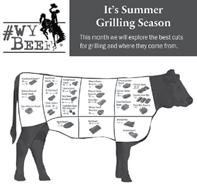
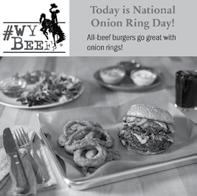
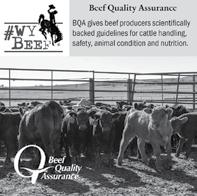
New UW educator welcomed
The University of Wyoming (UW) Extension recently appointed Rachael Stucke as the 4-H youth development educator for Teton County.

Stucke earned her bachelor’s in animal science from California Polytechnic State University in 2022, and went on to receive her Master of Animal Science from Colorado State University (CSU) in 2024. As a graduate teaching assistant at CSU, she taught students and lab volunteers about animal husbandry and handling. She believes her previous experiences will help her lead by example and work with different kinds of people.
Stucke is also well-versed in livestock research. Most recently, she worked as an agricultural science research technician with the U.S. Department of Agriculture Agricultural Research Service Meat Animal Research Center in Clay Center, Neb. In this role, she maintained livestock feeding equipment, facilitated livestock research projects and helped take care of cattle and swine.
“The 4-H program has a strong legacy in the Teton County community,” she says. “I am eager to learn all I can about that history and do my part to help it continue to leave a lasting impact.”
Stucke is especially looking forward to supporting 4-H’ers at the upcoming Teton County Fair.
Stucke started her new role with UW Extension on June 23. She can be reached at rstucke@uwyo.edu or 307-733-3087.
On July 8, U.S. Secretary of Agriculture Brooke Rollins, alongside U.S. Secretary of Defense Pete Hegseth, U.S. Attorney General Pam Bondi and U.S. Secretary of Homeland Security Kristi Noem, announced the next pillar of the Make Agriculture Great Again Initiative – the U.S. Department of Agriculture’s (USDA) National Farm Security Action Plan.
This historic plan elevates American agriculture as a key element of the nation’s national security, addressing urgent threats from foreign adversaries and strengthening the resilience of the nation’s food and agricultural systems.
The National Farm Security Action Plan will serve as the launching point for the USDA to work with governors, state legislators and federal partners to further integrate agriculture into the broader national security efforts over the coming months and years. Defending access to American abundance and preserving the American experiment is the essence of agriculture security and it is why farm security is national security.

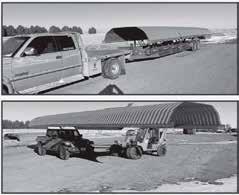
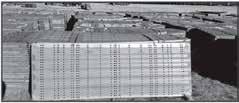
Clyde L. Winchester, Jr.
Nov. 25, 1970 – July 2, 2025

an accident.
Clyde was born on Nov. 25, 1970 in Lander to Clyde L. Winchester, Sr. and Pamela (Krost) Winchester. He was raised in Lander and the Diversion Dam area and graduated from Lander Valley High School. He spent his entire life in Wyoming, where he built a legacy of service, family and hard work.
He was baptized at the Church of Christ. On June 20, 1992, he mar-
Judith “Judy” Anne (Ellenberger) West
Feb. 14, 1942 – Jan. 26, 2025
Judith “Judy” Anne (Ellenberger) West of Chugwater passed away on Jan. 26.
Judy was born on Valentine’s Day in 1942 in Fort Morgan, Colo. She was the daughter of Herman and Ella Ellenberger. At the age of four, Judy and the family moved to Trinidad, Colo.
After graduating from
Trinidad High School in 1959, she attended the University of Northern Colorado and graduated with a bachelor’s degree in secondary education.
Judy went on to use her teaching degree to touch the lives of countless students in her 32 years as a math teacher. From Trinidad High School to Hoehne High and at the Chugwa-
ried the love of his life, Amanda L. Cunningham, in Lander. Together they raised two sons, Jacob and Colby. Ten months ago, Clyde welcomed his first grandchild, Grayson, who brought him immense pride and joy.
At the time of his passing, Clyde was employed by the Fremont County Road Department, where he had worked for over 10 years. His previous employment included positions at Wyoming Rentals, Valley Lumber and ownership of Himark Rentals.
Clyde was a lifelong sportsman and community supporter. As a youth, he
ter High School, she dedicated her life to helping her kids become proficient in math and life.
Judy’s dedication to education extended to the state level where she helped initiate the education standards used today. In addition, she volunteered her extra time to the kids through her involvement with local 4-H clubs, math competitions, quilting and Laramie Peak CattleWomen.
In 1964, Judy married the love of her life, Wal-
After moving away from hosting a traditional headliner concert in the grandstands to explore new options aimed at boosting attendance, the Wyoming State Fair’s (WSF) sister organization, the Wyoming State Fair Foundation, is excited to announce it will hold a fundraising concert at this year’s fair.
With a mission to “ensure WSF remains a vibrant celebration of the state’s agriculture, education, industry and heritage, while evolving to meet the needs of future generations,” all proceeds from the concert will go toward numerous projects, enhancements and opportunities available at the state fair this year and for years to come.
“Already this year we are bringing livestreaming of the shows, equipment like a skid steer and an ice machine, $50,000 worth of additional power to the livestock barns and a scholarship fund for high school seniors to apply to go to college or trade school,” shares Wyoming State Fair Foundation Executive Director Rindy West.
Further, West notes the concert will be the founda-
tion’s biggest opportunity to raise funds right out of the gate.
Sponsored by Navajo Transitional Energy, the concert will take place on Aug. 15 at the Ford Grandstand, with gates opening at 6 p.m.
Local Wyoming band Tris Munsick and the Innocents will open at 7 p.m., and Micky and the Motorcars, a Texas-based red dirt band known for their “rough-hewn” mix of country rock, bluegrass and folk, will headline at 8:30 p.m.
West points out one of the most exciting features of this year’s event is a shuttle system to and from the concert to the town of Casper.
“We are providing bussing tickets, which are available at wystatefair.com for $10 to and from the concert,” she explains. “The buses will leave the Hat Six parking lot at two different times and return after the concert. If hotels in Douglas fill up quickly, as they sometimes do, save yourself the drive and parking and stay in Casper. Anyone can purchase a bus ticket.”
General admission concert tickets are $30 each or $50 for “Dancing in the

played baseball and wrestled, later becoming a dedicated coach and mentor to local youth in both sports.
His spirit of service began at age 17 when he volunteered to fight the Yellowstone Fire. He later supported Central Wyoming College agriculture programs and volunteered countless hours in his community.
He loved the outdoors and enjoyed photography, jeeping, hunting, fishing, camping, snowmobiling and bull riding.
At just 14 years old, he pulled home a 1971 Pontiac LeMans and rebuilt it from the ground up. It remained his pride and joy
ter Thomas “Tom” West, and settled down in southern Colorado on the family farm. In 1990, she and Tom moved to Chugwater to the family ranch where she continued to teach and educate kids in southeastern Wyoming.
Judy retired in 1996 where she then became involved on the local school board for the next eight years and was instrumental for positive change and growth in the school district.
Judy had a love of
throughout his life.
Most of all, Clyde cherished time spent with Amanda and their sons, always embracing family adventures and gatherings with his large extended family.
Clyde is preceded in death by his niece Cortney Mole; uncle Dale Winchester; cousin Ryan Schroeder and grandparents Harold Winchester, Elleanora Hall, Floyd Dugan and Patricia Thompson.
He is survived by his loving wife of 33 years, Amanda Winchester; sons Jacob Dale Winchester and Colby Ray (Kelsey) Winchester; grand-
gardening, singing in the choir and quilting. One of her greatest passions was being out on the family ranch and riding her horse.
Judy is survived by her husband Tom; children Markia and Dean Anderson and Kit and Krista West; grandkids Decker, Ashlyn, Rory and Brody and her brother John Ellenberger.
As singing was always a great part of her life, the family will be dancing and celebrating her life with music during a celebration
son Grayson Ray Winchester; parents Clyde and Pamela Winchester; sisters Mary Kay Winchester and Sandra (Clint) Guyman; nieces and nephews Justine (Kevin) Kummer, Bryce Heiser, Tory (Deserie) Guyman, Shallary Guyman and Dalton Mole; great-nieces and nephews Kadance, Erik and Evan Kummer, Carmon Palmer, Torryn Mole and one more on the way and parents-inlaw Ron and Kathy Cunningham. He also leaves behind numerous aunts, uncles and cousins.
A memorial service was held on July 7 at the Fremont Center on the Riverton Fairgrounds.

of life on Aug. 9 at 4 p.m. at the ranch on TY Basin Road in Chugwater. For directions and more information, call Kit at 307331-0357.
Dirt” – dancing room right in front of the stage in the grandstands arena. There are also $200 VIP tickets available, which include first-pick seating and access to food, drinks and the VIP Tent.
All proceeds benefit the Wyoming State Fair Foundation and projects for WSF in coming year.
For more information or to purchase a ticket, visit wystatefair.com or call West at 307-751-3430.



A wall of water taller than a two-story house swept down Texas’ Guadalupe River in the middle of the night on July 4, displacing and killing people and destroying homes and structures in 21 of the state’s 254 counties.
Now, volunteers and agency personnel are searching for missing people and trying to save what’s left of farms and ranches.
“We still have over 40 people missing,” said Texas Agriculture Commissioner Sid Miller in a July 7 Fox News report. “Our death count is up to 82 people in those 21 counties. It will probably go over 100, unfortunately.”
Miller compared the amount of water in the Gua-
dalupe River to Niagara Falls.
“Within a 24-hour period, there was enough water coming down the Guadalupe River through Kerrville, Texas it would equal the water going through Niagara Falls in a month and a half,” he said. “It’s a very devastating flood.”
Agricultural toll Miller also discussed the catastrophic losses to agriculture, noting livestock found in the tops of trees and the loss of hundreds of miles of fencing, as well as buildings and structures.
“We’ve lost farm-tomarket roads, bridges, utilities, etc. We’re out of power,” Miller noted. “Irrigation systems have been wiped out. Crops are gone.
Crops are underwater. There’s missing livestock. Tractors are underwater and implements washed away. You name it, it’s happening in those 21 counties.”
Resources for help
While volunteers and agencies work tirelessly to find missing people, Miller offered the state’s crisis hotline, AgriStress, as a resource.
“I’m opening up to any and every Texan going through this mental anguish who has lost loved ones or has loved ones who haven’t been found or lost property,” he said.
The AgriStress hotline is 833-897-2474.
“I hope people take advantage of the hotline because it is absolutely

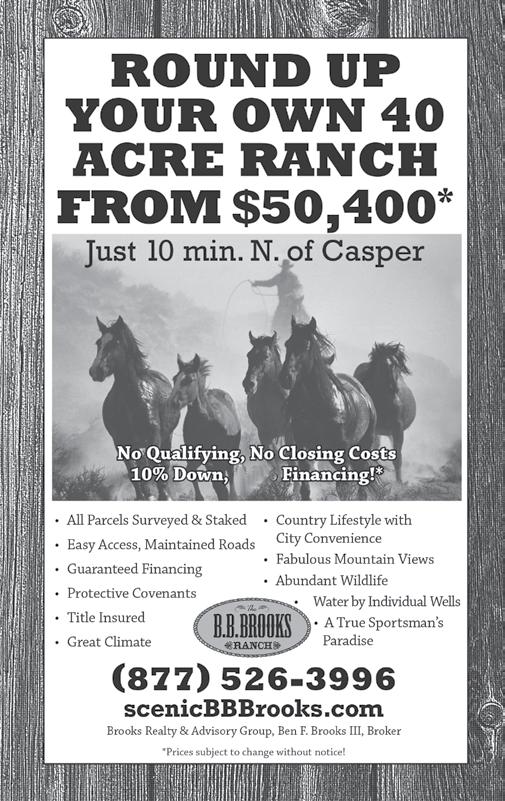

needed in situations like this,” he added.
Economic impact
The economic impact of this flood is not yet known. Miller said the loss of life is top tier, adding, “It supersedes everything.”
But a loss of livelihood is also going to need to be accounted for.
While the damage involves about 10 percent of the state, many areas outside of the 21-county region are under flash flood warnings as well.
“Hopefully, it doesn’t expand, but it’s certainly possible it could,” Miller said.
In the meantime, Miller said the state’s sole mission is to rescue people.
“Hopefully, we can find more and more who have survived,” he said. “More flash flooding and more rain hamper those efforts, but we’re going to be prepared. We’re expecting it now. It just caught us off guard at 3 a.m. when everyone was asleep – very little warning time.”
Miller noted the need for an improved alert system.
“The legislature is going to come back, and we’re going to fix this problem. We need to have a better alert system, not just for flooding, but for any type of emergency,” he said.
Assistance and donations
For those wanting to help, Miller welcomes donations to the Texas Depart-
ment of Agriculture’s STAR Fund, where funds are distributed to individuals and private entities.
“We get it back to farmers and ranchers to cover things insurance doesn’t,” he said. “This includes mostly fencing and buildings, burying dead animals, things like that.”
For more information, visit texasagriculture.gov
Those interested in making hay or livestock feed donations can visit the same website or call 512-7879966.
Shelley E. Huguley is the senior editor for Southwest Farm Press. This article was originally published by Southwest Farm Press on July 7.

Cattle producers from across the country were recognized during the industry’s Summer Business Meeting in San Diego through the 2025 Environmental Stewardship Award Program (ESAP).
Regional award recipients were honored for their commitment to conservation and stewardship, and the national winner will be announced during CattleCon 2026 in Nashville, Tenn. in February.
“It is an honor to recognize these cattle producers for their commitment to conservation,” said National Cattlemen’s Beef Association President Buck Wehrbein. “Not only are they protecting natural resources for future generations, but they also serve as stewardship role models for producers across the country.”
Region One honoree
The award winner from Region One is Whispering Hills Farm of Lawrenceburg, Ky.
Mike Wilson took a neglected and overgrown farm in the heart of Kentucky and gave it life. He carefully crafted his operation around the limitations of the land and resources and adapted when necessary to make it a thriving, profitable operation which can be passed down to the next generation of stewards.
Wilson is an active participant in the Environmental Quality Incentives Program as well as the Conservation Stewardship Program, working with the Natural Resources Conservation Service (NRCS) to implement a variety of practices including pipeline, heavy-use area protection, watering troughs, fencing and forage and biomass plantings to help facilitate prescribed grazing.
In addition to livestock related enhancements, he is an advocate for keeping the balance between agriculture and wildlife. He has partnered with state foresters to improve woodland, and he removes invasive species to enhance plant diversity.
Wilson continues to serve as a role model to fellow cattle producers, influencing them to take positive steps towards stewardship and conservation efforts.
Region Two honoree
Sitting at an urbanwildlife interface in central Florida and surrounded by one of the fastest-growing regions in the country, M&D Overstreet Ranch of Kathleen, Fla. is the Region Two honoree.
The Overstreet’s story is one of endurance, responsibility and a deep-rooted belief in leaving the land better than they found it.
Mark Overstreet, paralyzed from the waist down since 1970, has never let his disability keep him from stewarding the land. With modified equipment, sheer determination and an unbreakable spirit, he continues to oversee rotational grazing, soil restoration and
water conservation projects which benefit not just the cattle, but all of Florida.
M&D Overstreet Ranch uses controlled burns to restore native grasslands, lime rock lakes to recharge the aquifer and wildlife corridors to protect species like deer, turkeys and wading birds.
Overstreet remains a mentor and advocate, proving true leadership isn’t about personal success, it’s about lifting others up. His work ensures Florida’s ranching traditions, environmental stewardship and community values will endure for generations to come.
Region Three honoree
From Bankston, Iowa, Smith Family Farms is the ESAP Award Region Three winner.
In the family since 1853, the 100 percent notill Smith Family Farm is located in the rolling hills of northeast Iowa, today owned and operated by Jack Smith, his wife Maria and their two sons.
The Smiths’ agriculture philosophy is based on soil health, which is accomplished through the three pillars of no-till, cover crops and cows.
The Smiths have developed a cow herd which thrives in their environment by grazing throughout most of the year, limiting additional feed resources and calving out in the field.
Rotational grazing is another cornerstone for environmental stewardship – whether rotating on cover crops, corn residue permanent pastures or converting Conservation Reserve Program fields to pastures.
In addition to their conservation efforts, the family is dedicated to preserving
the state’s history through the Iowa Barn Foundation, which has saved more than 300 barns.
Above all, the Smiths share their story and mentor others on their environmental and operational practices.
Region Four honoree
Founded in 1877, McFaddin Ranch of Victoria, Texas – the honoree of Region Four – is a living testament to the resilience and innovation of Texas ranching.
Located near the Gulf Coast, McFaddin Ranch has worked for decades to hone grazing management practices to match the environment and optimize ecosystem services.
From proper stocking densities, genetics, handling, forage quality and flood and drought management, Co-Owner and General Manager Bob McCan continually seeks out new tools and approaches to enhance all aspects of the operation. These efforts have improved wildlife habitat, protected and enhanced water quality and increased carbon sequestration.
These stewardship efforts are helping the ranch meet its goals of integrating research-proven strategies to maintain thriving wildlife and livestock populations through complementary practices, using economic, environmental and social sustainability to guide decisions and continue the family’s ranching legacy.
In addition, McCan shares what he’s learned through leadership roles at the state, national and international levels.
Region Five honoree
G&G Livestock and Cathey Cattle Company of Polson, Mont. received

Region Five ESAP Award honors.
Greg and Lynn Gardner started G&G Livestock and their daughter Brittany Cathey and son-in-law Wacey Cathey later launched Cathey Cattle Company as their own direct-to-consumer beef business.
Located on the Flathead Indian Reservation, the family works together to manage cattle and care for the land.
Efficient range management is the family’s focus with efforts including weed control, grazing management and water development. By implementing a deferred rest-rotation system, the family has seen their pastures develop deeper roots, rebound more quickly from grazing and increase grass production year to year.
The family is active in the community and supports conservation causes to improve natural resources.
They partnered with NRCS to install addi-

tional fencing and livestock watering systems, treat invasive weeds, improve pasture and range conditions through forage plantings and develop grazing management plans leading to measurable improvements to rangeland health.
Region Six honoree Last but not least, Wine Glass Ranch of Imperial, Neb. was honored from Region Six.
Jeff and Connie Pribbeno and their son and daughter-in-law Logan and Brianna Pribbeno own and operate Wine Glass Ranch, located in western Nebraska near the Colorado border.
The Pribbenos believe long-term care for their operation’s ecology translates to profitability, which is why they have married together the values of ranching for profit and environmental stewardship to make a living.
The cow/calf, stocker and grain operation thrives despite the arid climate and
The family installed more than 200 miles of cross fence, creating 90 paddocks for their rotational grazing system. At any given point, 95 percent of the ranch is resting, and this practice has increased plant diversity and the return of native grasses such as sand bluestem and Indian grass, a species difficult to grow in sandy soil. With a focus on soil health, the Pribbenos work closely with several state and federal agencies on conservation projects, and those partnerships have helped them with their stewardship efforts.
Founded in 1898, NCBA is the marketing organization and trade association for cattle farmers and ranchers. With offices in Denver and Washington, D.C., NCBA is a producer-directed organization focused on industry advocacy, promotion, education and research. For more information, visit ncba.org

throughout eastern Wyoming, Nebraska and Kansas, which kept temperatures near to below average in these areas.
“Drought conditions overall remained unchanged or improved in eastern Wyoming and eastern Colorado into Nebraska and Kansas,” reports NIFC. “Northwest Colorado and southwest Wyoming, due to the hot temperatures and lack of rain, continued to see worsening drought throughout the month.”
Rocky Mountain
wildfire potential
While increased showers and thunderstorms have led to some green up across the Central Plains and the eastern plains of Colorado and Wyoming, it is also increasing fine fuel load due to abundant growth.
According to NIFC’s reports, in areas of both Wyoming and Colorado, west of the Continental Divide, fine fuels at lower elevations have already cured, while those at mid- to higher-elevations are generally greener and have been
impeding the spread of fire.
“The larger, dead, woody fuel classes are carrying fire due to the longer-term lack of moisture,” NIFC points out.
Additionally, the NIFC predicts temperatures will remain above normal from July through October, and – with the exception of southwest Colorado which will likely receive normal precipitation – the Rocky Mountain Region is also set to see below normal moisture for the rest of July.
The report notes, “There will still be a gradual increase in showers and thunderstorms as the monsoon starts to develop in the southwestern U.S. The monsoon is not looking as active as it once did, with activity being more sporadic. The initial push from each round of monsoonal may result in increased dry lightning potential on the West Slope. The remainder of the Rocky Mountain Region, through October, will remain below normal for precipitation.” Therefore, with hot dry
conditions expected across the West Slope, northwest Colorado and southwest Wyoming, NIFC forecasts increased significant fire potential in July while the rest of the area will continue to see normal fire potential.
Then, when moving into August and September, the agency believes the area of highest concern will be northeast Wyoming, which will likely see continued drought conditions and well below normal precipitation.
However, NIFC notes by October, the entire area’s fire potential will likely return to normal.
Nationwide predictions
At the national scale, NIFC says fire activity increased across the U.S. during the month of June, with the most notable increases in activity occurring in Alaska, the Great Basin and the Southwest.
“Activity increased more rapidly in the latter half of the month in the West, with the National Preparedness Level increasing to a three – on a scale of one to five – on June 21 due to
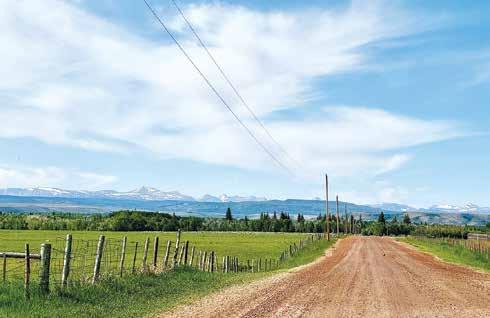
large fires burning in several geographic areas,” the report reads. “Total acres burned in the month of June was below the 10-year average at nearly 90 percent, with an above average tally of wildfires of 129 percent.”
Additionally, NIFC forecasts above normal fire potential throughout the majority of the Northwest and for much of central and southern California
through September.
Above normal fire potential is also forecast for most of Oklahoma and central and northern Texas in August, before returning to normal in September and October, as well as in northwest Minnesota from August through October.
In July, above normal fire potential is forecast for portions of the southern Great Basin, north-
west Colorado and southwest Wyoming, as well as the U.S. Caribbean Islands, before returning to normal in August. And, the lee sides of Hawaii will have above normal significant fire potential for all four months.
Hannah Bugas is the managing editor of the Wyoming Livestock Roundup. Send comments on this article to roundup@wylr.net.
University of Wyoming (UW) Extension welcomes Mallery Larson as the new agriculture and natural resources educator for Uinta County.
Larson has experience with livestock husbandry, production, management and research. As an undergraduate at the Univer-
sity of Idaho, she interned at a feedlot and conducted rangeland and meat science research.
Larson earned her master’s degree in animal and veterinary science from the University of Idaho in 2025. Her master’s thesis examined the effects of wildfire smoke on dairy cattle pro-
duction, which deepened her understanding of how the environment and livestock can impact each other.
Most recently, Larson worked as a research specialist with the University of Idaho. In this position, she worked with cattle and sheep, helped teach students and collaborated with
producers, staff and other researchers.

Larson spent 11 years as a 4-H member in Kootenai County, Idaho. She is excited to learn more about the county’s natural resources and use this to help Uinta County producers.
“One of the many reasons why I chose to pursue a degree in animal science is because I fell in love with the rural lifestyle and its stewards early on in
my life,” says Larson. “My dream job would be to work with different rural communities every day, providing them with the knowledge and resources to continue raising their livestock and crops in the most efficient and economical ways possible.”
Larson started her new role with UW Extension on June 23. She can be reached at mlarso34@uwyo.edu or 307-783-0570.




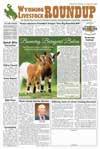








Bill provisions
According to several sources, some highlights of the bill include making tax cuts from the 2017 Tax Cuts and Jobs Act permanent and introducing new tax breaks, including eliminating taxes on tips and increasing the child tax credit to $2,200, which is $300 less than the initial legislation.
The bill includes a higher cap on state and local tax –from $10,000 to $40,000. However, after much debate, Congress decided after five years, this will go back down to $10,000.
There is also a “no tax on tips” provision in the bill, which would create new deductions for tipped workers, eliminating what they owe in federal income tax and allowing them to deduct a certain amount of tip wages and overtime from their taxes.
Additionally, the final bill would largely eliminate numerous tax incentives from the 2022 Inflation Reduction Act for clean energy, electric vehicles (EV) and energy efficiency programs, ultimately putting an end to tax credits on new and used EVs, the installation of at-home EV charging equipment and insulation or energy efficient heating and cooling systems.
Sources note the bill would also terminate the Greenhouse Gas Reduction Fund, which provides funding to nonprofit organizations who offer financing for projects which reduce pollution and greenhouse gas emissions. However, existing contracts and grants will not be affected.
Another major highlight of the bill are cuts made to Medicaid and SNAP.
For Medicaid, the bill imposes work requirements for able-bodied adults, as well as more frequent eligibility checks.
After some senators expressed their concern over how rural hospitals would be impacted by these restrictions, a rural hospital stabilization fund was added to the provisions, allocating $50 billion for rural hospitals.
In addition, the bill will shift the cost of SNAP – which is currently fully funded by the federal government – to states instead.
In a July 4 CBS News article, Authors Kaia Hubbard and Caitlin Yilek note, “The federal government would continue to fully fund the benefits for states that have an error payment rate below six percent, beginning in 2028. States with error rates above six percent would be on the hook for five to 15 percent of the costs. States are also given some flexibility in calculating their share.”
They add, “The package also aligns with the initial House version on age requirements for able-bodied adults to qualify for SNAP benefits. Currently, in order to qualify, able-bodied adults between 18 and
54 must meet work requirements. Both the Senate and House bills would update the age requirement to 18 and 64, with some exemptions for parents.”
Regarding border security and homeland defense, the One Big Beautiful Bill includes more than $46.5 billion for border wall construction and related expenses, $45 billion to expand detention capacity for immigrants in custody and about $30 billion in funding needed for hiring, training and other resources for U.S. Immigration and Customs Enforcement.
It also includes a minimum $100 fee for those seeking asylum, down from the $1,000 fee outlined in the initial bill.
Agriculture impact
Overall, the bill has gained major support from farmers, ranchers and rural communities.
In fact, this legislative package is set to strengthen the farm safety net by locking in key commodity programs like Agricultural Risk Coverage (ARC), Price Loss Coverage (PLC) and other crop insurance programs through 2031, while lifting reference prices for major crops like wheat, corn and soybeans by approximately 11 to 21 percent and integrating automatic annual adjustments with a built-in escalator capped around 113 to 155 percent of the original threshold.
For the 2025 crop year, producers can now automatically receive higher PLC or ARC payments with no elections needed.
Additionally, the inclusion of the Supplemental Coverage Option, alongside ARC, provides enhanced protection against weather losses and market volatility.
In an effort to safeguard generational land transfers, the bill is also set to pass permanent estate tax exemption at $15 million per individual or $30 million per couple. Preserving the “step-up basis rule” will likely also ease succession transitions and capital gains exposure.
In addition, the bill permanently enacts the 20 percent Section 199A deduction for pass-through farm income, along with an indexed minimum deduction. Expensing thresholds for farm equipment purchases will also be extended.
The bill also extends and strengthens the 45Z Clean Fuel Production Credit, restricting it to feedstocks grown in North America and boosting domestic soy and canola producers.
Mixed reaction
Many groups and individuals with strong voices in the ag industry have expressed support of the One Big Beautiful Bill.
U.S. Cattlemen’s Association (USCA) President Justin Tupper commented on the successful passage of the bill, stating, “This comprehensive piece of legislation, signed by the president on July 4, includes several
issues USCA has long advocated for and we will continue to engage in discussions as this moves forward.”
National Cattlemen’s Beef Association Senior Vice President of Government Affairs Ethan Lane also issued a statement, which reads, “America’s cattle farmers and ranchers are pleased by the final passage of the One Big Beautiful Bill. This legislation will protect family farmers and ranchers from the devastation of the Death Tax, it will avoid a massive year-end tax hike which could have put cattle operations out of business, it expands and protects many of the small business tax deductions family producers rely on to save more of the hard-earned money and it funds critical foreign animal disease prevention measures protecting cattle health.”
U.S. Secretary of Agriculture Brooke Rollins agrees with these sentiments, noting some of the most important measures of the

bill for agriculture include bolstering the farm safety net, making crop insurance more affordable, protecting producers from the Death Tax, preventing competing countries from flooding the market with biofuel feedstocks, enhancing domestic energy security and providing immediate tax relief.
“President Trump’s One Big Beautiful Bill is a win for farmers, ranchers, rural communities and American taxpayers,” she says. “His leadership on this landmark piece of legislation is yet another example of an America First promise made and a promise kept.”
Closer to home, Gov. Mark Gordon commented on how the bill will specifically benefit Wyoming.
“Today’s passage of the long-awaited reconciliation bill – The One Big Beautiful Bill Act – by the U.S. Congress is good for Wyoming,” he says. “Throughout the process, I worked closely with members of our Congressional delegation to

hone provisions of the bill of particular importance to Wyoming citizens and our state’s economy. I applaud their diligence.”
He continues, “Some of the excellent provisions in this bill include the lifting of a ban on coal leasing and a rollback of royalty rates on coal, oil and gas. These are industries critical to Wyoming’s fiscal health. I was also pleased to see the establishment of a $50 billion stabilization fund for rural hospitals, as well as the removal of both a prohibition on state efforts to regulate arti-
Austin Snook • 307-290-2161
Taylor Snook • 307-290-2273
Craig Deveraux • 307-746-5690
Dan Catlin • 406-671-7715
Clint Snook • 307-290-4000
1
2
ficial intelligence and a provision which would increase taxes on Wyoming’s trona industry.”
However, while Trump’s legislation is being celebrated by some as a win for American families, small business and the ag industry, critics warn it favors the wealthy, cuts vital social programs and opens the door to long-term fiscal and environmental consequences.
Hannah Bugas is the managing editor of the Wyoming Livestock Roundup. Send comments on this article to roundup@wylr.net.
Cheyenne Seymour • 605-641-0638 Kyle Kallhoff • 605-881-1526 Casey Sellers • 307-217-2614 Jim Forbes • 307-351-5932
"From the ring, to the video, and in the country, we market your livestock the competitive way."
9, 2025
Nice mid-summer run of Weigh Ups, selling on a fully steady market. No Sale next week. Thank you and we appreciate your business!
1 BLK-COW 1615 165.00 WT 2,664.75
KINCHEN RANCH LLC, KAYCEE WY
1 BLK-COW 1495 167.00 WT 2,496.65
1 RED-COW 1455 165.50 WT 2,408.02
2 BLK-COW 1773 160.00
SHEELEY RANCH, PARKMAN WY
2 BBROC-COW 1595 166.00 WT 2,647.70
1 HERE-COW 1430 158.00
MAYFLOWER CATTLE COMPANY, SHERIDAN WY 16 BLK-HFRTTE 1018 266.00
1
1 RED-HFRTTE 1095 226.00 WT 2,474.70
RODUNER CATTLE INC, BUFFALO
2,057.00 1
1195 173.00 WT 2,067.35
1 RED-COW 1365 165.50 WT 2,259.07
ERIC S & ELIZABETH BARLOW, GILLETTE WY 3 RED-COW 1282 164.50 WT 2,108.34
1 REDCOWETTE 1090 195.00 WT 2,125.50
2 RED-HFRTTE 955 256.00 WT 2,444.80
JEREMY W. YEAGER, BUFFALO WY
1 BLK-COW 1860 166.00 WT 3,087.60
1 BLK-COW 1355 166.50 WT 2,256.07
1 BLK-COW 1170 179.00 WT 2,094.30
RACHAEL MERCER, MANDERSON WY
3 RED-COW 1432 170.00 WT 2,433.83
1 BLKCOWETTE 1250 175.00 WT 2,187.50
1 RED-COW 1725 162.00 WT 2,794.50
1 RED-HFRTTE 960 242.00 WT 2,323.20
PERRY CATTLE LLC, CLEARMONT WY
1 BLK-COW 1360 160.50 WT 2,182.80
DANIEL OR SHERRYL FRAKER, KAYCEE WY
1 BLK-COW 1380 166.00 WT 2,290.80
1 BLK-COW 1305 167.00 WT 2,179.35
S. K. JOHNSTON JR, BIG HORN WY
7 BLK-COW 1268 182.50 WT 2,313.83
3 BWF-COW 1422 167.00 WT 2,374.18 2 BLK-COW 1718 165.00 WT 2,833.87
BLK-COW 1570 166.50 WT 2,614.05
BWF-COW 1595 164.50 WT 2,623.77
BLK-COW 1315
R BELUS, CLEARMONT WY 1 BLK-COW 1395 162.00 WT 2,259.90 RIATA RANCH LLC &, GILLETTE WY
BLK-COW 1420 167.00 WT 2,371.40 1 RED-COW
At a recent news conference, U.S. Secretary of Agriculture Brooke Rollins and the U.S. Department of Agriculture (USDA) announced a “bold new initiative” aimed at stopping the spread of New World screwworm (NWS).
On June 18, Rollins announced updates to USDA’s ongoing efforts to combat the threat of NWS near the Southern Border, including plans for an $8.5 million sterile fly dispersal facility in South Texas and a five-pronged approach to “enhance the USDA’s already robust ability to detect, control and eliminate” the threat of NWS in the U.S. Concerns for producers
News of the deadly screwworm – a parasitic fly with a penchant for live
New artificial intelligence (AI) technology is enabling agricultural retailers and farm supply cooperatives to optimize their operational performance while strengthening all-important customer relationships.
In addition to broadbased AI platforms which can be leveraged to simplify everyday business operations, farm suppliers now have access to AI apps specifically designed to support field agronomy and crop production.
Utilizing AI in agriculture
According to a new
flesh – has been rocking the agricultural sector since it was first reported in Central America in 2022, with reports of NWS in Mexico arriving by late 2024.
The parasite has been posing problems for cattle producers throughout Mexico. since it was first observed less than 700 miles from the U.S.-Mexico border.
An outbreak in the U.S. would pose serious risks to the cattle industry, as some of the nation’s largest cattle operations are located near the Southern Border in states like Texas and Florida.
Industry experts believe eradication of NWS is possible if elimination efforts take an aggressive and proactive approach.
Combative measures
Rollins’ recent initiative is the latest in a series of ongoing plans and legislation aimed at equipping U.S. agriculturists to stop the screwworm’s northward spread.
Roughly a week prior to Rollins rolling out the sterile fly facility plan, U.S. Sen. Ronny Jackson (R-TX) reintroduced the Foreign Animal Disease Prevention, Surveillance and Rapid Response Act to Congress.
The proposed act features a three-pronged approach to combatting foreign diseases like NWS and would provide essential long-term funding and support for infrastructure aimed at preventing, controlling and eradicating
foreign disease outbreaks such as the proposed sterile fly facility. As such, Jackson was quick to voice support for Rollins’ proposed initiative.
“The NWS poses a serious threat to our cattle, economy and food supply, but with Rollins’ leadership and USDA’s new fivepronged strategy, we’re taking aggressive action to stop it and protect America’s farmers and ranchers,” Jackson says.
“As the representative for the largest cattlefeeding district, I am committed to working closely with the secretary to ensure we have every necessary tool to safeguard our livestock producers and feeders and their way of life,” he continues.
Sterile insect technique
Sterile flies are the only proven way to stop reproduction of the NWS. The technique is used actively in Mexico and Latin America and was employed in the U.S. against NWS to the point of eradication decades ago.
In 1966, the U.S. successfully shut down an outbreak of NWS through the sterile fly technique, which works by hatching sterile male screwworm flies in captivity and releasing them to mate with wild females.
Since the screwworm only breeds once, this technique is generally effective in reducing numbers of reproducing flies.
Positive outlook
Although news of NWS
has certainly taken agricultural news by storm in recent weeks, the future does look promising. With all the buzz surrounding the screwworm, it is important to remember NWS has been eradicated using the sterile fly technique before, making Rollins’ proposed plan very good news for concerned agriculturists everywhere.
“The U.S. has defeated NWS before, and we will do it again,” Rollins emphasizes. “We have the proven tools, strong domestic and international partnerships and the grit needed to win this battle.”
Grace Skavdahl is the editor of the Wyoming Livestock Roundup. Send comments on this article to roundup@wylr.net.
research brief from CoBank’s Knowledge Exchange, AI technology offers ag retailers a new set of tools to optimize workflows, inventory management, employee performance and other key business functions.
Farm supply businesses rising to the challenge of adopting AI can also enhance their position as trusted advisors and essential partners in the ag supply chain.
“AI in agriculture can be utilized in a company’s back office or front office, as well as within agronomy

and supply chain operations divisions,” said Jacqui Fatka, CoBank farm supply and biofuels economist. “Early adoption and reliable partnerships will provide an advantage for those willing to test the AI landscape. Ag retailers should research companies and pick AI partners who understand agriculture and promise value beyond just lofty return on investments.”
Agricultural cooperatives and retailers serve as a critical relationship bridge between farmers and input providers. The potential erosion of those relationships due to alternative distribution models, disruptive technologies or other competing forces is one of the biggest challenges ag retailers face moving forward.
Early adoption of AI can help the ag retailer sector stay ahead of competitors while maintaining and strengthening customer relationships.
Fatka suggested ag retailers start with easy-toimplement, low-stakes AI applications for things like e-mail, presentation assis-
MX5200D TRACTOR
2023 CAT D6 DOZER CAT320 EXCAVATOR 2023 CAT 420 BACKHOE 2023 CAT 906 LOADER 2018 CAT 930M LOADER 2022 FRIESEN TRAILER AIR COMPRESSOR
CAT REACH FORKLIFT (TELEHANDLER)
2023 SA CARGO TRAILER 6X10 NEW PULLED
1500 MILES - $7,000.00
2023 CARGO TRAILER 7X18 - $11,000
CAT PD 10000 FORKLIFT
2013 JLG G6-42A EXTENDED BOOM SKYJACKSJ7135 SCISSOR LIFT
THE BEST PRICES YOU CAN FIND!!!!
To read CoBank’s research brief on how artificial intelligence is empowering ag retailers in its entirety, visit cobank. com/knowledge-exchange/grain-and-farm-supply/ how-ai-is-empowering-agriculture-retailers?utm_ source=mediabase&utm_medium=email&utm_ campaign=knowledge-exchange&utm_content=ai.
tance and customer interaction summaries before tackling more complex tasks.
“Testing out different pathways to gain internal acceptance can lead to greater long-term success. For instance, an easy initial test might be recording virtual meetings with CoPilot. Within minutes, it can deliver an AI-generated summary of the meeting with key takeaways, immediate action items and future tasks,” Fatka said.
Ag retailers can also start leveraging AI to optimize workflows for standard business functions like human resources, accounting, operations and sales.
Using AI to evaluate and streamline these functions offers a high return on investment relative to the efforts required to build or
implement such tools.
However, Fatka stresses, companies should establish guardrails for the use of customer information and understand privacy changes with the use of AI tools. Benefits of AI
While AI is unlikely to eliminate ag retail jobs, it can help simplify tasks and reduce human error or bias.
In addition, as labor continues to be a challenge for many rural enterprises, it can provide continuity during labor turnover.
AI can also help agronomists and other staff cover more acres or customers.
Apps like AgPilot enable agronomists to interact with AI verbally while traveling between customers, allowing them to input crop protection recommendations and
smoothly advance potential sales from one stage to another.
“The stakes are high for agribusinesses operating in an environment where margins are tight,” said Fatka. “However, ag retailers will need to ensure AI costs do not outweigh the benefits. The cost of experimentation is minimal, and delaying a trial adoption of these promising tools could result in missed opportunities for growth.”
CoBank is a cooperative bank serving vital industries across rural America. The bank provides loans, leases, export financing and other financial services to agribusinesses and rural power, water and communications providers in all 50 states. This article was originally published on June 18.

FORESTS continued from page 2
treatments needed. It’s time we untied their hands instead of hindering their every move.
These restrictions have impacted every wildfire-prone state.
In Montana, 58 percent of national forest lands have been off limits to commonsense management to prevent this tragedy. In Utah, it’s nearly 60 percent, and in Alaska’s Tongass National Forest, the largest in the country, 92 percent has been taken off the table.
The rule was supposed to protect drinking water –it failed. More than 3,800 municipal watersheds are now at risk. For example, burned areas produce 350 to 450 percent more sediment in reservoirs than managed timber harvests. This directly threatens the water supply.
The cost of this inaction is staggering.
National forests are the single most important source of drinking water in the U.S. Eighty million Americans across thousands of communities and in large cities depend on the clean drinking water flowing from our National Forest System – valued at more than $8 billion.
The Roadless Rule was supposed to reduce the maintenance cost of USFS roads – it failed. Deferred maintenance has remained unchanged. Instead, the rule made it nearly impossible to establish a reliable timber supply, cutting off access to family-supporting jobs and revenue streams for remote communities. It also made it harder to maintain forest roads which serve hunters, anglers and first responders.
Our forests need thoughtful management, not neglect.
Under Trump’s leadership, we are changing course. We are restoring authority to local line officers, cutting red tape and giving USFS the ability to manage the lands effectively.
The Roadless Rule has failed. It’s time to turn the page. Let’s give forest stewards the tools they need. Let’s unlock America’s resources, protect our communities and build a stronger, safer future for our forests.
Brooke Rollins is the U.S. Secretary of Agriculture. This opinion column was originally published in Deseret News on June 24.

WSF Board member. “As our country marks its 250th anniversary, this designation celebrates Wyoming’s unique heritage and our contributions to the American story. It’s a great time to reflect on our past, celebrate the present and look ahead to a promising future.”
The WSF, now celebrating 120 years of honoring agriculture, youth and Western heritage, is proud to help kick off this monumental celebration. As the official fair
of Wyoming and a longstanding symbol of rural tradition, the fair aligns naturally with the spirit of America.
“At the WSF, we’re all about celebrating Western heritage,” said Shawn Steffen, president of the WSF Board. “And let’s be honest, nothing says America like the Wyoming way of life.”
Rooted in the traditions that built the country – agriculture, hard work, resilience and a strong sense of community – state fairs
have long served as a unifying space where people of all walks of life come together.
This legacy continues in Wyoming, where patriotism and pride run deep.
“Most Wyoming citizens are very patriotic, and fairs are a celebration of the heritage and legacy of their regions,” said Laurie Boner, Converse County representative on the WSF Board.
“The WSF aligns well with the mission of America 250 – any time we can cel-
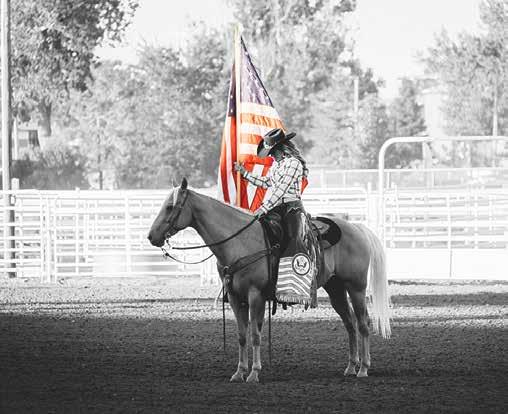
ebrate patriotism and the dedication of our military, both past and present, is an opportunity we are honored to participate in.”
Through exhibits, grandstand events and fairground festivities, the 2025 WSF will highlight the people and industries that power not just the state, but the nation – agriculture, education, natural resources and service.
“At the WSF, we love the fair industry, and we love our country,” said Courtny Hinds, WSF general manager. “America was built on agricultural roots and the very values we champion every day – agriculture, education, youth and Western lifestyle. This is why we’re excited to participate in the Great American Fair Initiative and showcase the best of Wyoming while celebrating everything that makes our nation truly great.”
The 2025 WSF will take place Aug. 12-16 in Douglas and promises a patriotic showcase of the Cowboy State’s culture, traditions and people.
Fairgoers can expect a mix of entertainment, educational exhibits and community celebrations that tie directly into the Great American Fair Initiative.
Kota Provence is the WSF marketing and communications liaison. For more information, visit wystatefair.com



Improved feed management involves a lot more than how to store it. Expanding one’s thinking can save tens of thousands of dollars each year while enhancing nutrition, herd health and production.
Feed costs are the largest expense for ranchers and cattle feedlot operators, typically making up 50 percent or more of total operating costs.
Bagging silage has proven to be an efficient way to reduce feed waste, but when it was further examined how bagging can impact the entire feed management and handling process, even greater savings were discovered.
While all cattle operations are different, these discoveries may open producers’ eyes about how much they can save.
Starting with the equipment, new innovations can produce higher-quality feed at a lower cost. This is particularly true for silage, a preserved forage made from energy-rich crops such as corn, alfalfa, sorghum or grass which undergo fermentation under anaerobic conditions.
While silage has traditionally been stored in silos, bunkers, piles or pits, more cattle operations are shifting to bagged silage to maintain optimal fermentation and ensure long-term feed quality.
This transition requires investing in bagging equipment, which initially can be more expensive than building a concrete pad or pit. As a result, these cattle producers evaluated both the initial purchase price and the expected reductions in feed loss.
But this evaluation is limited given the broader financial advantages, which
include better nutrition preservation, reduced health risks, improved breed-back times, increased storage flexibility, lower labor requirements and increased potential revenue opportunities.
This is where the conversation shifts from simply justifying an equipment purchase to understanding its long-term financial impact.
By recognizing the ripple effect across an entire operation and how the financial benefits align, the decision to bag silage easily justifies the investment.
Reducing silage loss saves operations money
In addition to grazing, a typical U.S. ranch with 100 beef cattle might use between 1,500 and 2,500 tons of silage annually. Larger operations with 1,000-plus cattle can require 15,000 to 25,000 tons per year.
One of the main disadvantages of storing silage using traditional methods like piles, pits and bunkers is the considerable risk of spoilage and loss, which can amount to as much as 30 percent. This combined loss is often referred to as “shrink.”
“The problem with conventional silage storage methods is excessive exposure to oxygen, which leads to rapid silage deterioration. Standard practice is to leave the face of the pile, pit or bunker open for feeding. This leaves hundreds of square feet exposed and deteriorating before it can be fed,” says Steve Cullen, president of Astoria, Ore.based Versa Corporation, a global leader in agricultural silage bagging and handling.
A key advantage of properly bagged silage is the smaller feedout face, which reduces daily exposure to air, thereby minimiz-
ing spoilage. This design ensures silage is consumed more quickly, preserving its freshness and maintaining its nutritional value.
Harvesting is a timedriven process. As ranchers rush to protect their valuable crop, tractor packing time is often cut short, leaving oxygen still in the pile. With silage bagging, the oxygen is removed almost instantly and fermentation begins promptly.
Even at a conservative 15 percent, the savings derived from reducing shrink are substantial.
Whether cattlemen must harvest additional feed each year or purchase more to offset losses, annual feed loss accrues year after year to reduce long-term profitability. More retained nutrients equals less feed needed
The higher-quality silage produced in bags further reduces feed costs by providing greater nutrient density. Limiting oxygen exposure reduces the risk of yeast and mold growth.
These contaminants consume essential carbohydrates and proteins, leading to nutrient losses, lower digestibility and potential mycotoxin production which can harm cattle health.
“The feed is more nutritious because we are not losing nutrients to those spoilage microorganisms, and we are not introducing contaminants into an animal we are asking to grow rapidly,” explains Dr. Keith Bryan, technical service manager of silage and dairy for global biosolutions company Novonesis.
“Animals eat to meet their energy and nutrient needs. So, if the silage is suboptimal and retains only 90 percent of its full nutri-
ent density during the ensiling process, then we have to feed 110 percent of the silage to get the same total nutrients into the animal,” adds Bryan.
A correctly managed silage bag also produces higher levels of lactic acid, which enhances digestibility and translates to better nutrient absorption. Lactic acid plays a key role in improving feed efficiency, and studies suggest it is almost directly absorbed into cattle’s bloodstream along with essential nutrients.
Improved feed management brings additional savings
Bagging becomes a valuable tool for cost-effective cattle management. The increased flexibility and versatility reduces labor, enhances safety, eliminates the need for additional equipment and allows for the storage of a broader range of high-value feed options.
One of the primary benefits of using a bagging machine is the ability to store and manage small quantities of different feed types such as alfalfa, corn, grass-legume mix, sorghum or oats.
If needed, cattlemen can even designate sections within a single bag for different crops, such as marking one portion for wheat and another for corn. This method allows for greater versatility in feed storage without the inconvenience of physically separating crops in a silo, where it would be challenging to determine where one type starts and another ends.
Placing various crops and cuttings into bags offers cattlemen the flexibility to create silage and mixed rations tailored to their spe-

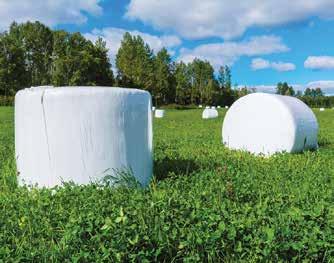
cific needs and even the cow’s stage of development.
A major advantage is bagging feed is much more forgiving when it comes to moisture content. Sealed bags preserve silage quality and sustain optimal fermentation conditions even amid unfavorable circumstances such as exposure to rain, moisture, excessive dryness or prolonged storage.
Bagging provides the flexibility to start and stop as needed, especially in unpredictable weather. Unlike traditional methods which risk missing peak nutritional value due to delays, bagging allows cattlemen to pause and resume without sacrificing feed quality. Feed moisture levels can vary, affecting the daily rations. By blending feed from multiple bags, producers can minimize these fluctuations, ensuring a more consistent nutrient supply.
Bagging also is an effective storage method for highmoisture corn silage, particularly for snaplage, earlage and other head-chopped concentrate feeds. Snaplage and earlage consists of the entire ear – cob, kernels, husk and part of the shank –harvested and ensiled at an optimal moisture range of 32 to 40 percent.
Rather than relying on expensive dried grain, producers can bag head chops from barley, wheat or earleaf snaplage as a near pound-for-pound replacement, reducing feed costs and maximizing on-farm resources.
These high-energy concentrates rival dry grain in nutrition, making them an efficient alternative for cattle. Expanded storage options go beyond silage
Expanding bagging beyond silage improves efficiency, reduces costs and can even create revenue streams from materials which would otherwise go to waste.
For instance, when an upright silo reaches full capacity, any additional grain must be stored elsewhere. In many cases, excess corn is simply piled outside, exposed to the elements, which can lead to spoilage and a decline in quality.
Rather than selling immediately when supply is high and prices are low, cattlemen can store their surplus in bags and wait for demand to rise, maximizing their returns. This storage flexibility offers a finan-
cial advantage by reducing the impact of oversupply on market prices.
Many cattle operations already bag corn and hay but may not realize they can do the same for byproducts like beet pulp, tomato pulp and spent grain – ethanol and brewing byproducts.
These byproducts offer cost-effective feed options, often available at little to no cost, but spoil quickly without proper storage.
Regardless of the material stored, bagging can preserve the contents for up to three years with proper management, reducing waste and ensuring a stable feed supply.
Creative Financing, revenue opportunities
The portability of bagging equipment allows relocation to different sites, optimizing usage and allowing cost-sharing or reduced investment expenses.
Shared ownership among neighboring farms helps lower the financial burden by splitting acquisition and maintenance expenses. By leveraging its mobility, cattlemen can also use the bagger for local contract work, offering silage bagging services to other operations. This can serve as an additional income stream or a way to reduce overall harvesting costs.
When adding it all up, silage bagging presents a compelling financial advantage for cattle operations, saving 30 to 50 percent while transforming feed management into a more efficient, cost-effective and profitable practice.
Cattlemen can save tens of thousands of dollars annually while maintaining higher nutrient retention, extending feed life and improving herd health. The ability to better control feed quality and minimize spoilage not only enhances overall production but also leads to improved reproductive efficiency, reduced veterinary costs and lower labor expenses.
Additional uses for bagging saves money and adds new revenue streams.
Overall, these cumulative benefits contribute to a more sustainable and financially resilient operation.
Carlo Chatman is the media relations specialist for Power PR, a media relations firm dedicated to helping industrial companies. For more information, visit powerpr.com

On July 8, Mexico’s National Service of AgroAlimentary Health, Safety and Quality (SENASICA) reported a new case of New World screwworm (NWS) in Ixhuatlan de Madero, Veracruz, in Mexico, which is approximately 160 miles northward of the current sterile fly dispersal grid, on the eastern side of the country and 370 miles south of the U.S.-Mexico border. This new northward detection comes approximately two months after northern detections were reported in Oaxaca and Veracruz, less than 700 miles away from the U.S. border, which triggered the closure
Excellence in Extension Award in 1998 – the highest honor in UW Extension – and the Meritorious 4-H Award in 2003.
Finally, in 2023 following his retirement from Extension, Cunningham was inducted into the Wyoming Agriculture HOF.
During Cunningham’s Extension career, he was always the epitome of a leader and organizer of educational events.
He served as president of WACAA multiple times, including from 1982-84 and 2001-04.
He also led major organizing efforts and initiative teams for agriculture and natural resources programming across Wyoming unlike any other per-
son in UW Extension history. Many of the major events he organized are still ongoing today.
Major programs such as Fremont County Farm and Ranch Days, several
of ports to Mexican cattle, bison and horses on May 11.
While the U.S. Department of Agriculture (USDA) announced a risk-based phased port reopening strategy beginning as early as July 7, this newly reported NWS case raises significant concern about the previously reported information
cattle artificial insemination schools and the Lander Valley Garden Expo were all started during Cunningham’s tenure and continue to be some of the absolute best annual Extension programs offered in Wyoming today.


shared by Mexican officials and severely compromises the outlined port reopening schedule of five ports from July 7-Sept. 15. In order to protect American livestock and the nation’s food supply, U.S. Secretary of Agriculture Brooke Rollins has ordered the closure of livestock trade
through southern ports of entry effective immediately.
“The U.S. has promised to be vigilant and after detecting this new NWS case, we are pausing the planned port reopening’s to further quarantine and target this deadly pest in Mexico. We must see additional progress combatting NWS
in Veracruz and other nearby Mexican states in order to reopen livestock ports along the Southern Border,” said Rollins. “Thanks to the aggressive monitoring by USDA staff in the U.S. and in Mexico, we have been able to take quick and decisive action to respond to the spread of this deadly pest.”
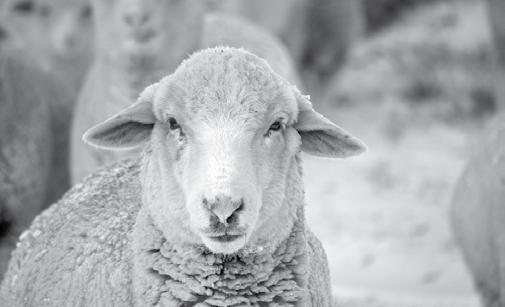

July 24
July 26
July 9-13
Wyoming Quarter Horse Association 2025 Cowboy Summer Classic, Pepsi Equine Center, Wyoming State Fairgrounds, Douglas. For more information, visit wqha.org
July 11-13 Wyoming Sheep and Wool Festival, Johnson County Fairgrounds, Buffalo. For more information, visit wyomingsheepandwoolfestival.com
July 11-19 Converse County Fair, Douglas. For more information, visit conversecountyfair.com
July 12-18 University of Wyoming Sheep Program Sheep Innovators Exchange New Zealand. For more information or to apply, visit bit.ly/4gF2Lm2 or e-mail woolinitiative@uwyo.edu.
July 15-16
Wyoming Game and Fish Commission Meeting, Ramkota Hotel and Convention Center, Casper. For more information, visit wgfd.wyo.gov
July 16 WyoGives Day, online. To donate, visit wyogives.org
July 17-19 2025 U.S. Targhee Sheep Association National Show and Sale, Miles City, Mont. For more information, visit targheesheepus.com/show-sale
July 18-27 Cheyenne Frontier Days, Cheyenne Frontier Days Event Center, Cheyenne. For more information or to purchase tickets, visit cfdrodeo.com
July 19 Albany County CattleWomen Ranch Tour, Laramie. For more information, call 307-760-5590 or visit wyaccw.com
July 19-27 Teton County Fair, Jackson. For more information, visit tetoncountyfair.com
July 19-27 Washakie County Fair, Worland. For more information, visit facebook.com/ washakiecountyfair/
July 21-Aug. 2 Albany County Fair, Laramie. For more information, visit albanycountyfair.org
July 22-25 2025 American Lamb Summit, University of Idaho, Moscow, Idaho. For more information or to register, visit lambboard.com
July 22-26 Park County Fair, Powell. For more information, visit parkcountyeventsandfair.com
July 23-26 Sublette County Fair, Big Piney. For more information, visit sublettecountyfair.com
July 25 Wyoming State Fairgrounds Volunteer Day Three, 9 a.m.-3 p.m., Wyoming State Fairgrounds, Douglas. For more information, visit wystatefair.com
July 25-26 Red Desert Roundup Rodeo, Sweetwater Events Complex, Rock Springs. For more information or to purchase a ticket, visit rdrodeo.com
July 25-Aug. 2 Niobrara County Fair, Lusk. For more information, visit facebook.com/NiobraraCountyFair
July 25-Aug. 3 Campbell County Fair, Gillette. For more information, visit campbellcountywy. gov/2280/Fair-Week-Activities
July 25-Aug. 3 Platte County Fair, Wheatland. For more information, visit plattecountyfair.org
July 26-Aug. 2 Crook County Fair, Sundance. For more information, visit crookcofair.com
July 26-Aug. 2 Fremont County Fair, Riverton. For more information, visit fremontcountyfair.org
July 26-Aug. 2 Goshen County Fair, Torrington. For more information, visit goshencounty. org/226/Goshen-County-Fair
July 26-Aug. 2 Hot Springs County Fair, Thermopolis. For more information, visit facebook. com/hscfairgrounds
July 26-Aug. 2 Uinta County Fair, Evanston. For more information, visit uintacountywy. gov/1080/Uinta-County-Fair
July 26-Aug. 3 Johnson County Fair, Buffalo. For more information, visit johnsoncountyfairgrounds.com/fair
July 26-Aug. 3 Sweetwater County Fair, Rock Springs. For more information, visit sweetwaterevents.com
July 26-Aug. 3 Weston County Fair, Newcastle. For more information, visit westoncountyfair.org
July 27-Aug. 4 Sheridan County Fair, Sheridan. For more information, visit sheridancountyfairgrounds.com
July 28-Aug. 3 Big Horn County Fair, Basin. For more information, visit bighornfair.com
July 7-11 Superior Livestock Auction Week in the Rockies, 800-422-2117, superiorlivestock.com
July 7-13 Colorado Horse Sale Saddle Horse Sale, online at coloradohorsesale.com, 970-744-8989
July 11-12 Mile High Summer Classic Sale, Adams County Fairgrounds, Brighton, Colo., 970-381-3649, joshwhiteauctions.com
July 14-16 Western Video Market, Silver Legacy Casino Resort, Reno, Nev., 530-3473793, wvmcattle.com
July 15 Ellis-Campbell Ranch Equipment Auction, 12852 Road 51, Torrington, 307532-4976, 307-534-5156, mcnameeauctioncompany.com
July 21-23 Northern Livestock Video Auction Summertime Classic, 866-616-5035, northernlivestockvideo.com

Big Horn Basin Livestock Auction will be having their last summer sale Thursday, June 26.
We will be tearing out the indoor ring to put in ring scales the months of July and August. Due to the construction, we will not be having any live auctions during these months.
We apologize for the inconvenience this may cause. If you have livestock that you need to market during these months, please contact Danny Vigil at 307-388-0781 or the office at 307-347-9201. We will start with our first Thursday sale on September 4, 2025. We appreciate your understanding.
Stellpflug Cattle Company “New Frontier” Female Sale, at the ranch, Guernsey, 307-351-1712, stellpflugcattle.com
South Dakota Sheep Growers Association Premium Yearling Ewe Sale Magness Livestock Auction, Huron, S.D., 406-581-7772, sdsheepgrowers.org
July 28-Aug 1 Superior Livestock Auction Video Royale, 800-422-2117, superiorlivestock.com
Aug. 11-12
Aug. 12-13
Aug. 18-19
Aug. 18-22
Aug. 23
Aug. 23
Western Video Market, Little America, Cheyenne, 530-347-3793, wvmcattle.com
Cattle Country Video Oregon Trail Classic, Gering Civic Center, Gering, Neb., 888-322-8853, cattlecountryvideo.com
Northern Livestock Video Auction Early Fall Preview, 866-616-5035, northernlivestockvideo.com
Superior Livestock Auction Big Horn Classic, 800-422-2117, superiorlivestock.com
Memory Ranches Third Annual Foal Sale, at the ranch, Wells, Nev., 208412-6156, 208-695-0399, memoryranches.com
Colorado Horse Sale, Adams County Fairgrounds, Brighton, Colo., 970-7448989, coloradohorsesale.com


“Do, Lord, Do Remember Me” was the hymn which rang out at the First Presbyterian Church of Saratoga during a recent Sunday morning worship.
Members of the congregation sang not only for their souls and salvation, but in remembrance of the first 135 years of Saratoga’s second-oldest church which was established July 10, 1890.
This remembrance will be celebrated this coming Sunday morning, July 13, beginning at 10:30 a.m. in the Sanctuary and Fellowship Hall located on the corner of Bridge and Third streets. The celebration is not just to mark a milestone century-plus 35 years of organization and worship, but to heed God’s call for all to come together.
During the centennial celebration back in 1990, the pastor led the worship with the following call and response.
Unless the Lord builds the house, those who built it labor in vain.
Unless the Lord watches over the city, the watchman stays awake in vain.
How lovely is thy dwelling place, O Lord of hosts.
My soul longs, yeah, faints for the courts of the Lord.
My heart and flesh sing for joy to the living God.
Blessed are those who dwell in thy house, always singing thy praise.
The message is still relevant today.
Records show in 1889 the Ladies of the Home Missionary Society was organized in Saratoga before a church existed. At the time the aid was established there was neither church or minister.
A 1890 newspaper account states, “All the good Christian people of the valley who believed in God were united in
Christian work regardless of creed. All united in the belief to have a Sunday School for their children and to have a society for their women folk would better the newlyborn town, giving the traveler and the newcomers to the valley more of a desire to settle down and establish a decent place to live.”
This philosophy has prevailed throughout the decades and is the guideline for many more years to come at the First Presbyterian Church of Saratoga.
Over the past century and a third, the Presbyterian Church has evolved into the “community church” with its doors open to all those who seek the Lord and Jesus Christ.
Its organization is the second oldest in the valley, yet it has been in continuous ministry the longest of any congregation here. St. Barnabas Episcopal Church was Saratoga’s first, being established in 1888.
A 1990 news item noted the purchase and
hanging of the church bell in 1896 marked another step in the rapid advancement of the Presbyterian Church.
The item further declared, “Now as then, the church is out of debt, has a good membership and is, even now, none too large to accommodate the interested congregation which assembles there to listen to the teachings of its pastor.”
All those interested are invited to attend the 135th birthday celebration this Sunday at the First Presbyterian Church of Saratoga. And keeping with tradition, the ladies – in this case the Deacons – of the church will provide a fried chicken dinner with all the fixins, plus cake and ice cream at noon to which all are invited.
As the Presbyterian Church celebrates its 135th birthday this Sunday, may all Christians remember, “Do, Lord, Do Remember Me” and also recall the hymn which many sang as they marched from the sanctuary pews to Sunday School held in the soggy basement – “Onward Christian Soldiers.”
Happy 135th birthday to the First Presbyterian Church of Saratoga and its congregation.
Everyone is invited to join in the celebration Sunday morning, July 13, beginning at 10:30 a.m.
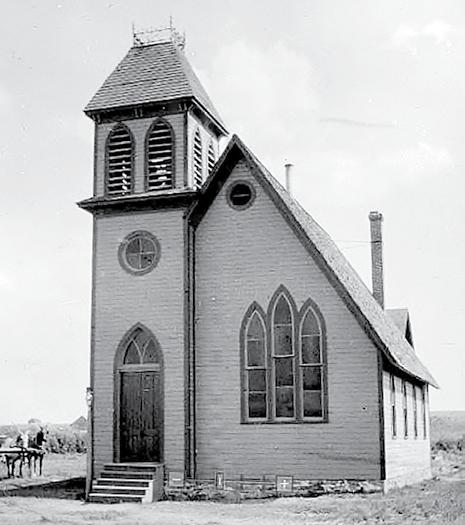
Dak 26-28/cwt
Source: USDA AMS Livestock, Poultry & Grain Market News, Torrington
Source: USDA AMS Livestock, Poultry & Grain Market News, Greeley, CO
National Sheep Summary
As of June 27, 2025
Compared to last week Slaughter lambs under 120 lbs mostly steady, over 120 lbs steady to 4.00 higher. Feeder lambs steady. Slaughter ewes steady. Good demand for all weights of slaughter lambs, good demand for feeder lambs, moderate demand for slaughter ewes. All sheep sold per hundred weight (CWT) unless otherwise specified. Slaughter Lambs: Choice and Prime 1-3 San Angelo: wooled and shorn 50-60 lbs 254.00-285.00 6070 lbs 252.00.00; 70-80 lbs 254.00. Billings: No test.
Ft. Collins: wooled and shorn 40-50 lbs 255.00; 50-60 lbs 240.00-245.00; 60-70 lbs 240.00-245.00 70-80 lbs 240.00250.00; 80-90 lbs 240.00-255.00; 90-100 lbs 245.00-252.50. Sioux Falls: 50-60 lbs 220.00-242.50; 60-70 lbs 225.00232.00; 70-80 lbs 22.50-242.50; 80-90 lbs 205.00-224.00; 90-100 lbs 210.00-223.00; 100-110 lbs 205.00-219.00; 120-130 lbs 210.00-218.00; 130-140 lbs 214.00-223.00; 140-150 lbs 221.00-222.00; 160-170 lbs 201.00.
Equity Coop: No test. Slaughter Ewes San Angelo: Good 2-3 92.00-142.00; Good 4-5 106.00. Billings: No test.
Ft. Collins: Good 2-3 80.00-130.00; Good 4-5 90.00-127.50. Sioux Falls: Good 2-3: 65.00-90.00; Good 4-5: 70.00-90.00; Utility 1-2: 55.00-85.00. Feeder Lambs: Medium and Large 1
San Angelo: No test.
Billings: No test.
Ft. Collins: No test.
Sioux Falls: 50-60 lbs 255.00-285.00; 70-80 lbs 245.00. Equity Coop: No test. Replacement Ewes: Medium and Large 1-2 San Angelo: No test.
Ft. Collins: No test.
South Dakota: No test.
Billings: No test.
Sheep and lamb slaughter under federal inspection for the week to date totaled 37,000 compared to 37,000 last week and 34,833 last year.
Source: USDA AMS LPG Market News, San Angelo, Texas
Source: USDA- CO Dept of Ag Market News Service, Greeley, CO
Nebraska Hay Summary As of July 3, 2025
Compared to last two weeks ago, all reported forages sold steady to a little weak. Demand was light at best. Recent rains across the state have halted demand for old and new crop hay and the prices feel like it could slip downward a tick. The US drought monitor still has most of the state from abnormally dry to moderate drought. Some areas of the state have had over 20 inches of rain since Memorial Day weekend, and the soil profile is still dry. If the rain shuts off during the dog days of summer, it won’t take long for forages to turn brown and tonnage to fall off substantially. That may increase the demand for hay down the road.
Primarily dry weather occurred west of the Continental Divide in Colorado and Wyoming. Temperatures across the region were mostly near normal to 2-4 degrees above normal, though parts of the eastern Dakotas were a few degrees cooler than normal. In areas that received heavy rain, soil moisture and precipitation deficits were alleviated and widespread improvements to ongoing drought or abnormal dryness occurred, including a twocategory improvement in central Nebraska where some of the week’s heaviest rains fell. Meanwhile, degradations occurred in northwest Colorado and western Wyoming, where soil moisture and streamflow deficits mounted amid growing precipitation deficits. The next available report will be Thursday, July 17, 2025. Mountains & Northwest Montana
Prairie/Meadow
Source: USDA-AMS Dept of Ag Market News Service, Greeley, CO
CORRECTIONS AGRICULTURE CORPS PROGRAM
SUPERVISOR: Are you a seasoned ag leader wanting to make a real difference?
send
or provide per-
information to an advertiser. If you have questions or believe you have been the victim of fraud, contact the Wyoming Attorney General’s Office, Consumer Protection Unit, 109 Capitol Building, Cheyenne, WY 82002, 307-777-6397 TFN
CALL FOR ANTIQUE TRACTORS/ENGINES/MACHINES to Antique Tractor Pull July 19 from 9 a.m.-3 p.m., Gillette, WY. For more information, call 307-682-5723, Rockpile Museum 7/12

and fill out an application or visit our website at Call Brandon Furr at 402-257-7769 or 402-746-2222 for more information.
LOOKING FOR A FULL-TIME FARM/RANCH EMPLOYEE:
Seeking a motivated individual to assist in day-to-day operations of our working ranch. The role supports the current foreman and works alongside to ensure smooth and efficient operation of livestock, haying, equipment and facility management. Applicant must have a strong agricultural background and a hands-on approach to problem solving and daily ranch work. The position is long term and offers a clear path to increased responsibilities, pay and leadership over time. Location of the ranch is remote. Housing is provided and on a school bus route. Position open immediately. Please send resume with references by mail or e-mail to: PeeGee Ranch, 1251 Lower Powder River Road, Arvada, WY 82831, pgranch@ rangeweb.net. Call 307-7362461 7/12
HEREFORD SEEDSTOCK OP-
ERATION NEAR CHEYENNE, WY LOOKING FOR FULLTIME RANCH EMPLOYEE. Duties include: Calving, extensive AI program, calf wintering and extensive fencing and corral repair. Plenty of cattle work but not a lot of riding. Housing and utilities provided and good schools on a bus route within 20 miles of home. Salary and DOE. Please send resume and references to jaberryherefords@ msn.com or call 307-634-5178 7/26
Join Wyoming’s Department of Corrections as a Corrections Agriculture Corps Program Supervisor in Riverton, WY. You’ll manage everything from seed planting to harvest, supervise inmate workers and teach essential life and vocational skills while supporting livestock feed programs and sustaining farm equipment operations. Three to 4 years’ experience in agriculture/ farming or bachelor’s in ag. Knowledge of crop science, irrigation and farm equipment. Strong leadership and safety awareness. Rewarding opportunity to contribute to public safety and inmate rehabilitation. $24.78/hour +full benefits: Tuition reimbursement, retirement, health care. Riverton, WY, Wyoming Honor Farm. Learn more and apply: www.governmentjobs.com/careers/wyoming/ jobs/4943010/correctionsagriculture-crops-programsupervisor-2025-01356
Grow with us, help cultivate futures, both in the field and beyond. #WyomingJobs #Agriculture #Reentry #PublicService #LeadershipOpportunity 8/2
HELP WANTED: LOOKING FOR AN EXPERIENCED RANCH HAND/LABOR. Haying, maintenance, operating equipment, well work, etc. Must be able to work 10-12 hour days if needed. Also, mornings on the weekends occasionally. Free room and board, outside Medicine Bow, WY. Call 605580-0493 7/19
FULL-TIME FARM/RANCH HAND WANTED: Experienced in farming, haying, irrigation, equipment maintenance, fencing and livestock care/handling. CDL and welding experience preferred, references required, location northeast Wyoming. Please e-mail tamij.jci@gmail.com, fax, 307-896-3164 or call 877-896-2261 7/19
WASHAKIE COUNTY IS SEEKING APPLICANTS FOR A FULLTIME EQUIPMENT OPERATOR WITH THE ROAD AND BRIDGE DEPARTMENT. CDL is required. For more information, please contact Road and Bridge Superintendent Stuart Bower at 307-388-4848 7/12

CONSTRUCTION BY OATES
ENTERPRISES: Offering custom welding and dirt construction: Livestock pens, feeders, pipe fencing, road work repair, pad building, excavation for mechanical into homes and businesses, pond reclamation, NRCS registered vendor. Free estimates, www.constructionxoe.com. Call Levi Compton at 254-433-3434, Casper, WY. To view photos, go to www.wylr.net in the classifieds 7/19
AGRI-ONE FINANCIAL: Farm/ ranch and all commercial loans. RATES AS LOW AS 5%. We have been helping with all aspects of agricultural, commercial financing and management for years. LET US HELP YOU on a consulting level with management to increase profitability, deal with and fix credit problems and for all your financing needs. WE CARE AND HAVE WORKING PROGRAMS designed for the farmer/rancher and not the banker. Please call Steve, 303-7733545 or check out our website, www.agrionefinancial.com. I will come to you and get the job done!! 7/12

307-899-3737 7/26
BERNEDOODLES AND GOLDENDOODLES READY
NOW!! Pups are non-shedding hypoallergenic, come with UTD shots, microchipped, dewormed and health guarantee. Happy to arrange delivery or do a FaceTime. Visit www.yellowstonedoodles.com Newspaper special, price $2,000. Please reach out with questions. Call 307-272-5976. To view photos, go to www.wylr. net in the classifieds 7/19
AKC SPRINGER SPANIEL PUPPIES. Health tested. Call 307-575-5703 to find your next best friend!! To view photos, go to www.wylr.net in the classifieds 7/12
AKC LABRADOR RETRIEVER PUPPIES, yellow, ready July 10, will be vet checked, first shots and dewormed. Very cute and playful. Call 307-2726738 7/26


BULLS FOR SALE: Registered yearling and 2-year-old Black Angus range bulls for sale private treaty. Good selection for heifers and cows. From popular sires and industry leaders. Semen tested and ready to go. CLAY CREEK ANGUS, 307762-3541, www.claycreek.net 7/12
MYDLAND
RED ANGUS 2-YEAR-OLD FORAGE BULLS FOR SALE: Bulls for heifers and cows. Smaller framed, efficient, easy fleshing, good dispositions. Not fat, but in great shape and ready to go to work. Have been worked with dogs, on foot and horseback. Raised in rugged, rough, steep, rocky, high elevation country. Red Fork Red Angus, Ken & Cheri Graves, Kaycee, WY, phone 307-7382247, cell 307-267-0724, email gravesredfork@rtconnect.net 7/19

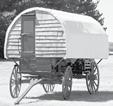

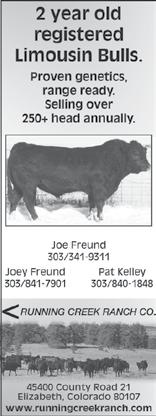
CUSTOM FEEDING AND FINISHING FOR CATTLE AND SHEEP. Cactus Hill Ranch Company, Fort Collins, CO. Contact AJ Nelson, 970-372-8273 8/2
FAITHFUL FEEDERS: Heifer development, backgrounding, and grass calf prep. Billings, MT. Call Ryan, 406-696-0104 4/11
PARK COUNTY, WY RANCH NEAR CODY, WY IS AVAILABLE FOR A LONG-TERM LEASE: The ranch has over 50,000 acres and supports an irrigated hay base with BOR water rights. Carrying capacity is 700 animal units year-round with hay production. Willing to split the hay ground and grazing. Please e-mail Honora Beirne (hbeirne@acpg.com) and Melanie Giliati (mgiliati@ acpg.com) for details 7/19
WELL STOCKED FOR ARENA, RANGE AND ABOVE THE PLAINS!! Gear up for SUMMER!! Large SELECTION of SADDLES, head stalls, REINS, saddle PADS and more!! WE CAN ship!! Shop Moss Saddles, Boots and Tack, 4648 West Yellowstone Highway, Casper, WY; 307-472-1872. Our family serving yours for 50 years!! Check us out on Facebook or our website 7/12


TONS AND TONS OF HAY FOR SALE!!! Alfalfa, alfalfa/grass mix, straight grass (crested wheat and native grasses), winter wheat, 1,300-1,350 lb. net-wrapped round bales. Deliveries are available if needed or come and get it. Sheridan, WY area. Call the ranch, 307-737-2680 or 307-7512068 (cell) 8/2
CERTIFIED WEED-FREE PURE ALFALFA HAY: Small squares, averaging 70-80 lbs. each. 2025 first cutting available for $225/ton. ALSO, 100+ tons of 2024 hay with weather damage. Would be good cow hay or great for compost. $50/ton. Will load trucks and any open trailer. MONIDA OATS: $16/cwt. Combine run. Will auger into truck, trailer or large totes/ag bags. Located between Powell and Cody, WY. Call or text Knopp Farms for details, 307-2540554 8/16
GERDES HAMPSHIRES HAS 32 REGISTERED PUREBRED HAMPSHIRE RAMS: Born in the winter of 2025. Our rams are big framed, fast growing with plenty of depth, muscle and bone. These are wether-producing type Hampshires without excessive leg length but possess tremendous thickness of loin and leg. Rams are sired by stud rams purchased from leading Hampshire sheep breeders at national sales and are sired by sons of Unicorn, UFFDA and Jackalope. For more information, call or text Darrell Gerdes of Madison, S.D. at 402-760-0104. To view photos, go to www.wylr. net in the classifieds 8/30 Sheep
CERTIFIED ORGANIC ALFALFA/GRASS MIX HAY: No chemicals, 3x3 squares and round bales. Adrian Troyer, Byron, WY. Call 307-631-4104 12/27
HAY FOR SALE: Approximately 430 tons of 2024 straight rye grass and grass/alfalfa mix. No sorting, Cody, WY. Call 307899-4532, early mornings or before 9 p.m. 7/26
July 26, 2025 @ 2 p.m. • Huron, S.D. Magness Livestock Auction

HAY FOR SALE: 2022 first and second cutting alfalfa. 2023 first and second cutting alfalfa, milo and grass/alfalfa. 2024 first and second cutting alfalfa, grass/alfalfa. ALSO, haybet barley, call for feed analysis. GRINDING HAY also available. UPCOMING 2025 NEW CROP, first cutting alfalfa and grass/alfalfa mix. All in net-wrapped round bales. Semi load delivery available. Call for pricing, ask for Klint, 701-290-4418, send a text if no answer or keep trying 7/26
90 NET-WRAPPED ROUND BALES, 1,500 lbs. grass/alfalfa mix, 2024 crop, $125/ton. Located in Cody, WY. Calls only, 307-899-3737 7/26
CERTIFIED BARLEY STRAW FOR SALE, 3x4 bales. Cody, WY. Call 307-899-1952 TFN
VALLEY VIDEO HAY MARKETS, LLC: Representing 40 of the best growers in eastern Wyoming and western Nebraska. Call now for your summer/fall needs, Barry McRea, 308-2355386, www.valleyvideohay. com 7/19
ROUND-BALED GRASS: 2024 crop $40/bale. 1,000 lb. net-wrapped bales. Cody, WY area. Call, don’t text, Anthony at 307-254-2645 8/16


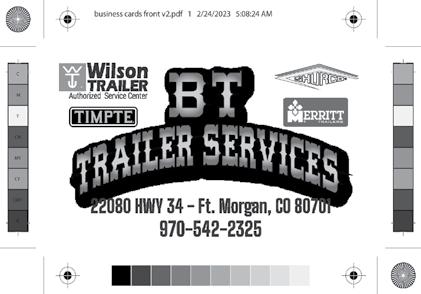
BARLEY STRAW: Certified weed-free small squares, $4/ bale. ALSO, 5x6 round bales, $125/ton. GRAIN OATS, wheat and barley, $20/cwt. Greybull, WY area. Call 307762-3878 or 307-899-4714, leave message 7/12
2012 FORD F650 FLATBED: 6.7L Cummins, Allison automatic. Good condition, 18’ flatbed, Vanair PTO driven air compressor, 161,000 miles. Best offer. Golden, CO. Call Eric at 720-312-9582. To view photos, go to www.wylr.net in the classifieds 8/2
FEATHERLITE 2001, 3-horse, gooseneck, slant load. Large, carpeted tack room, water tank and excellent tires. $8,750. Leave message, 307-6348410, Cheyenne, WY 8/2
FOR SALE: 2008 FORD
F350, 4x4, 6.4 diesel, Super Cab, 170,000 miles, deleted with Many Max Tuner at 70,000 miles, air bags, grill guard, Bradford flatbed with boxes, fifth wheel ball, tires above average, $15,000. 2012 CHEVY C2500, 4x4, 4 door, gas, 243,000 miles, power windows, power locks, A/C, grill guard, flatbed with toolboxes below and both rails, fifth wheel ball, excellent tires, $7,500. 2003 TOYOTA PRERUNNER, 4 door, 2WD pickup with 4 cylinder, 180,000 miles, hail damage, excellent tires, $2,000. Reese 16k fith wheel camper hitch, $500. For more information, call 719-688-8971 7/19
LIVESTOCK TRAILERS FOR SALE!! 2013 4-STAR STOCK TRAILER, 8’x40’, 3 axle, 2 cut gates, Sure Step rubber floor, excellent condition, $40,000. 2021 WILSON CATTLE TRAILER, 53’ long, dual-dual lift, plank nose decking floor 75% to 80%, 22.5 tires 75%, half doghouse, 10’ nose, 15’ tail, ready to go to work, excellent condition, $72,500. 2022
EBY LIVESTOCK TRAILER, hog friendly, like NEW condition, 3/4 doghouse, 22.5 tires, winter kit with toolbox extruded post, stainless steel nose and rear, extra light package, black skin, trailer has been sitting for a year, does have salvage title, $80,000. Located in Blomkest, MN. Delivery available. Call 320-905-4490. To view photos, go to www.wylr. net in the classifieds 7/12
WANTED: LARGER STRAIGHT WATER TRUCK, prefer 1,0005,000 gallon. Please call 605580-0493 7/12

RETIREMENT SALE!! Corral panels, Cattle Master squeeze chutes, John Deere 6400 tractors ($40,000/each), Peterbilt 379, step deck trailer. Call 208-6518698 8/2
ARTSWAY 786A BEET DEFOLIATOR: 6 row 22 inch, 1 steel, 2 rubber drums. Steerable wheels, scalpers, extra parts. Very good working condition. Call 406-5910797 8/2
LODGEPOLE OUTDOOR FURNACES, 307-223-2046. Your authorized Central Boiler Dealer. Get your outdoor wood furnace today!! $2,000 tax credit on qualifying models!! Efficient wood heat. Heat multiple buildings. Invest in your heating, don’t just pay for it!! See us at www.cb.lodgepoleproducts. com!! 7/26
JOHN DEERE 4230, 70-SERIES: Cab, A/C and heat, power shift with John Deere 158 loader, 9,000 hours. $15,000 or consider trade. Call 406-847-2636 7/26
FOR SALE: Lorenz 16’x29’ 17 ton bale mover. Tonutti 9 wheel finger rake. Rowse 9’ pull type mower. Rowse 9’ 3 pt. mower. H&S 14 wheel high capacity vrake. New Holland H7460 16’ pull type discbine. 2024 AGT mini excavator H13R with tracks, new machine, $5,000. Ford 7N tractor with wide front, runs great. John Deere 3975 silage cutter with 3RN green cutter head. Burns portable calf creep feeder. Burns portable loading chute. For-Most cattle working chute with palp cage and automatic headgate. 2020 Freightliner, automatic transmission, DD13 engine, 178” wheelbase, 407,673 miles, runs and drives nice. Miller Pro 5100 18’ chuckwagon with bunk feeding extensions and tandem running gear. H&S 7+4 18’ chuckwagon with bunk feeding extensions and tandem 14 ton running gear. 12’ HD box scraper with tilt. All in very nice condition!! Call 605-999-5482 7/26
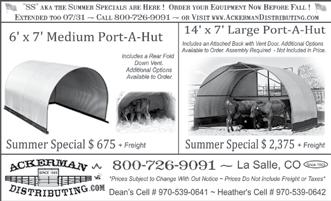
MONTANA RAILROAD SERVICES: Railroad ties, switch ties and other railroad materials for fencing and landscaping. Best pricing and quality in the region. Call 406-962-3514, Silesia, MT. Located 10 miles south of Laurel, MT (off of Clarks River Rd., the old highway). Visit our website www.mtrrservices.com 7/12
MANUFACTURER OF HEAVY DUTY CONTINUOUS FENCE: Corral panels, farm gates, free standing panels and more. Call for pricing and delivery, Rocky Ridge Welding, Nevada, MO, 417-549-1077 8/9
LODGEPOLE PRODUCTS, 307-742-6992, SERVING AGRIBUSINESSES SINCE 1975!! Treated posts, corral poles, buck-and-rail, western rail, fence stays, rough-sawn lumber, bedding. SEE US at www.lodgepoleproducts.com and click our “Picking A Fence Post” tab to see why folks choose our posts!! TFN
Have Property to sell? Advertise Here!
HIGH END PROPERTY. FARMHOUSE/COUNTRY HOME ON 20+ ACRES. An hour and 20 minutes from Denver, CO. This property is beautifully designed, fully remodeled, everything new. Four bed (2 master), 2 full bath, barn, silo, Quonset hut and outbuildings. Breathtaking panoramic views of hills and mountain range. Used to be the 29 Racehorse Ranch. Price sharply dropped, $525,000. For more information, call 720-602-8668. To view photos, go to www.wylr. net in the classifieds 7/19

NEW MEXICO RANCH 209+ ACRES, 38 miles to Albuquerque, N.M. Incredible mountain views and your livestock from a 1,000+ sq. ft. deck. 2,843 sq.
Two
and
3
2
Pipe corrals, grow
2
pens, hay/implement/ livestock barns, horse/tack/tool,
round pen area, vet clinic. $1,450,000. First Class Realty Services, Susan Wilson qualifying broker/realtor 505328-4172, contact Jay 505-2637419. To view photos, go to www. wylr.net in the classifieds 8/2
CASE 1070 TRACTOR: 5,000 plus hours, with Du-Al loader and grapple. $12,500. Calls only, 307-899-3737 7/26
EQUIPMENT FOR SALE,
FARMER RETIRING: John Deere 71 Flex 8 row corn planter on a 24’ stackable bar. AC Model 1300 30’ ripper with rakes. A 20’ Krause offset disc (new blades in front). 24’ Model 630 John Deere tandem disc. Safety pull with a bull hitch. 2003 IHC 9400I Eagle semi fifth wheel truck, CAT engine, 26’ end dump trailer with roll tarp. 1997 Kenworth T800, Detroit engine, 20’ box with hoist, roll tarp, both beet and grain end gates. John Deere front suitcase weights. IHC front suitcase weights. Contact Greg Keller at 406-679-1136 7/19
FOR SALE: WATER TRAILER with (4) 1,500 gallon water tanks, 3 cones, 2 pumps, 50 ft. hose, electric start. ALSO, International 1256 tractor and John Deere 4520 tractor. Call 701290-2504 7/12
915 JOHN DEERE RIPPER ON A CADDY. $8,500, good condition. Call 970-520-1320 7/12
1960 JOHN DEERE 95 COMBINE, round back, 16’. All new belts, stored inside, overhaul on engine. $2,500. Call Ivan, 307629-0974 TFN
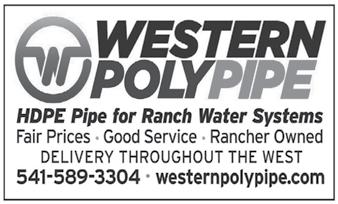
PIPE FOR SALE!! 2 7/8”, 3 1/2” tubing, 4” drill pipe, 4 1/2” casing, 5” casing, 7” casing. Rods 3/4”, 7/8” and 1” located in Montana, can ship anywhere. Call Mike, 602758-4447. To view photos, go to www.wylr.net in the classifieds 7/26
IRRIGATION PIVOTS FOR SALE, www.zimmag.com
Irrigation systems are COMPLETE with custom sprinkler package, SORTED, BUNDLED and ready to ship ● 2020 Zimmatic 8500 8 tower 1,296’ ● 2013 Valley 7000 7 tower 1,336’.


12’ KUHN ROTARY HYDRO SWING MOWER WITH FLAIL CONDITIONER: Field ready, model number FC 353GC. $10,000 OBO. Contact 307760-8429 7/26
ORIGINAL ROUND BALER BELTING FOR ALL MAKES: Save $100s. Free shipping, www.balerbelts.com. Call Hammond Equipment, 334627-3348 10/25
WE WILL PICK UP SCRAP IRON: On-site processing and removal. Receive $$$ top dollar $$$ for your junk!! Call for details, Pacific Steel and Recycling, 307-234-6006. Casper/ Central Wyoming 7/12
WANTED: BUFFALO BILL CODY COMMEMORATIVE MEDALLIONS, COINS OR TOKEN COLLECTORS. Lots of silver and bronze for sale or trade at Up In Arms Gun Show, Cody, WY, Sat., July 12 and Sun., July 13 Call Montana Gerry’s at 406439-3013 7/12
WALK-IN COOLER FOR SALE: Approximately 7’x15’, 5 display doors, compressor condenser and LED lights, all used less than one year. Great for food, drinks, butchering or floral. $6,500 OBO. Call 307-6606573 7/12
5TH ANNUAL ART AND MUSIC FESTIVAL JULY 26 CRAZY WOMAN SQUARE, BUFFALO, WY 9 a.m. to 5 p.m. Chalk Art, Paint Out, music, art, performers and vendors. Dance 7-11 p.m., music by Saddle Tramp. Sponsored by Colleen & Shawn Delaney. For more information, call Johnson County Arts & Humanities Council, 307-217-1979, e-mail jcahc16@gmail.com or visit www.jcahc.org 7/19
“The


Good time management is essential to farming success. That’s why more farmers are turning to T-L center pivot irrigation systems. Hydrostatically powered, T-L’s simple design gives you the low maintenance time, cost, safety and reliability to let you manage your farm instead of calling electricians or replacing gearboxes. Simplify your complex world and make irrigation easier on you.

man who stops advertising to save money is like the man who stops the clock to save time”

the same time I enjoy goats because it’s essentially something new to conquer,” Kasun says. “It reengaged me into showing.”
Kasun got her start showing goats four years ago with the help of former exhibitor Chase Taylor of Riverton, who has since become a good friend and trusted mentor. Kasun says her confidence showing goats grows with each passing year, but she still trusts Taylor for advice in selecting high-quality animals to add to her show string each season.
Kasun also looks to local producers when it comes time to pick out her cattle projects each fall, favoring Shepard Show Steers out of Wheatland and LeClair Cattle Company in Lander.
In addition to showing livestock, Kasun is active in livestock judging. She competes with her high
school’s FFA chapter during the school year, in addition to traveling to clinics and camps across the country throughout the summer and hopes to eventually go to college on a livestock judging scholarship.
Earlier this summer, Kasun took home first place at a livestock judging clinic at Texas Tech University. She credits her showing experience as a main pillar of her success in livestock judging and vice versa.
“Showing livestock has allowed me to increase my knowledge about livestock functionality,” Kasun says. “It really teaches you how to observe the animal and try to make them better as you’re showing them.”
Impressive achievements
In addition to honors in judging livestock, Kasun has been recognized for impressive achievements within the show ring.

“Being able to show high-quality animals nationally and compete with people across the country has been one of my favorite accomplishments,” Kasun says.
Kasun has exhibited champion stock in both species at jackpots and fairs alike.
In 2024, her market goat Stanley won grand champion at the WSF. That year Kasun also exhibited the Grand Champion Breeding Doe at the DinoMite Classic in Vernal, Utah.
Other favorite memories include being crowned reserve grand champion at the WSF Market Calf Show two times and finishing second in her class at the North American International Livestock Exposition with her market steer Ray in 2024.
“That calf was an absolute creature, and I’m very proud I had the opportunity to show him,” Kasun says.
“A big thing for me is the experiences you can have through showing animals,” she adds. “It’s not every day a kid gets to go showing in Kansas City, Mo. and Louisville, Ky. It just takes you across the nation and you get to meet so many people, make memories with them and experience so many things.”
“It also allows me to connect with my family and friends,” she continues, noting many of her friends are involved in agriculture and showing livestock.
Kasun’s parents also showed when they were around her age.
“It’s family heritage, essentially,” she states.
Collective effort
Kasun is quick to emphasize the impact her community has had on her show career. She credits her parents as the primary source of support.
“None of this would be possible without them,” she says. “They are always


pushing me to be my best self in and out of the show ring.”
She also highlights the impact her “tribe” of fellow and former exhibitors have had on her many successes, crediting Hirshell and Kelli LeClair, Ty Velasquez, Zac Weston and Brooks Shepard for being important mentors in her show career, as well as Taylor specifically for her involvement with showing goats.
“Everyone in our tribe, as we call it, has taught me important lessons I will never forget and always use in my life,” Kasun says.
Kasun has also learned lessons from inside the show ring. Her dedication to her craft is clear from her outlook on every outcome.
“No matter how good you do or don’t do, throughout the wins and losses there are always lessons to be learned and
experiences to be taken away from showing,” Kasun says.
“I think it’s important to use those lessons – and those losses – to fuel your drive and competitiveness for future years, no matter what you’re doing,” she concludes.
Grace Skavdahl is the editor of the Wyoming Livestock Roundup. Send comments on this article to roundup@wylr.net.
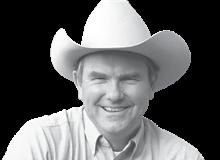

Read and Heed by Lee Pitts
When I was 12, my father transitioned from being a long-haul truck driver to being a heavy equipment operator because driving his semi on long trips was interfering with his drinking. His offspring took this news hard because we all looked forward to his absence.
Despite his uncountable flaws, there was one thing my old man was good at –he could drive anything with a steering wheel or levers. He started by operating a backhoe, then a bulldozer and finally a truck crane.
As part of his training, he was given a pamphlet with the signs he needed to learn to operate a crane such as boom up, spool out, etc. I thought it would be neat to memorize these signs, although I never got a chance to use them as a writer or a rancher.
Far more important to me would have been a pamphlet showing the hand signals your wife uses to help back up a trailer, so I’ve put together a list all husbands should memorize to keep harmony in the home. Men, from personal
experience I’d say you should hang this list on a wall in your tack room or shop and refer back to it before embarking on any trailering experiences with your significant other.
1. Shaking her fist at you – This implies you just ran over your wife’s gardening bucket, broke the handle on her small shovel and flattened the bucket.
2. The okay sign – You probably think this means you have backed the trailer into its ideal location, but then you would be wrong – again. Your wife is trying to tell you from afar that zero is the number of animals you will able to load or unload in your trailer’s present location.
3. Jumping jacks –When your wife is waving her arms over her head while jumping up and down, it doesn’t mean she’s exer-
cising. It means “Whoa Nellie” because you just backed into your antique loading chute which was only being held together because the termites were holding hands.
4. When she covers her face and tries to hide her identity – This signal is usually used when trying to unload or load cattle at the auction yard and it’s necessary for you to back your trailer into an alley. After about the 15th try, your wife is so embarrassed she tries to hide her identity and wants to go into the witness protection program.
5. The “you’re out” sign in baseball – You’ve highcentered the trailer and, in the process, you tore out all of the wiring running under the trailer, thereby requiring 12 hours to fix the trailer lights –and still, the turn signals will come out backwards.
6. Your wife is raising her fist above her head and shaking it at you – No, she’s definitely not giving the “Black Power” sign like those American athletes did years ago at the Olympics. I have firsthand experience with this signal, and it indicates you just put a huge dent in her beloved 25-yearold truck that she drives to work every day and everyone compliments her for having such a beautifullyrestored pickup. Not any more they won’t.
8. Your wife appears to be stirring a bowl of cake batter – I borrowed this signal from the crane operator’s pamphlet, only I’m assigning it a different meaning. What she’s saying is, “You’d make a better short order cook than a truck driver.”
9. Slashing her throat –This usually happens at a bull sale when you’re trying to load out with all your friends watching and people are waiting in line behind you to load out. It means, “Let’s put a merciful end to this nonsense and let me drive so we can both avoid further humiliation.”
WARNING – The signs your wife uses may vary and it behooves you to learn the many variations.
Happy trailering everyone.
7. When she keeps tapping her wristwatch and steam appears to be coming out of the top of her head –No, she’s not attempting to communicate with you with smoke signals. She’s really mad and is asking, “Where did you learn to back a trailer up, ya big dummy? And is there any chance you might get the trailer in its appropriate spot before nightfall?”




Four local students from Natrona County High School’s Casper FFA Chapter recently returned from an unforgettable international trip, where they not only represented Wyoming on the global stage, they also brought home a win.
The team, made up of Emmy Hornecker, Garrett Burkett, Carter Cox and Madi Dickinson and coached by Heath Hornecker and Jeremy Burkett qualified for a two-week trip to Scotland and Ireland after performing exceptionally well at both the national FFA and 4-H contests.
International contests
Heath notes the team set out for Edinburgh, Scotland on June 17, where they first competed in the Royal Highland Show.
Unlike competitions in the states where teams judge beef, sheep, swine and goats and individual team member scores are compiled into a single team score, the Royal Highland Show required the Casper FFA Chapter to predetermine if they would judge cattle or sheep and split their team into two pairs.
Individually, Emmy finished the competition fourth overall and Cox placed sixth overall, but had they been paired together, they might have taken the win, Heath notes.
The Charleville Agricultural Show in Cork, Ireland was also different than the students were used to. In this competition, all four team members worked together to submit one set of placings. Their tight-knit team dynamic and hard work paid off as they secured a first-place finish, tying with a team from North Dakota.

“The Ireland contest was extra special,” said Heath. “It was the first time all four of them judged together as one team. They had to talk through their decisions and agree on placings. To see them come together and win like that was a highlight of their careers.”
In addition to the different contest set up, Heath notes international livestock are a lot different as well, and they are selected under different criteria than those in the U.S.
“For example, we are used to cattle that go out and survive on big open range,” he explained. “In Scotland and Ireland, cattle run on pastures around 50 acres, so there are just some different selection criteria we had to focus on.”
To prepare for this, the team spent some time before the contest in Scotland talking to local producers.
Cox comments, “The animals we judged looked very different than the animals back home, so we had to tweak our placing factors to fit what the officials were looking for. At the Royal Highland Show, we went
around talking to several of the breeders, asking them questions about what we should look for in the contest. This helped us gain a lot of knowledge about the cattle in these countries.”
Unique opportunity
The two-week trip wasn’t all business however.
The group, which included the four-man team, two FFA advisors, several parents and a grandmother, also took time to explore Scotland and Ireland’s rich culture and vibrant scenery.
Heath shares they had the opportunity to visit iconic landmarks like the Edinburgh Castle, the Ring of Kerry and the Blarney Castle, where the students kissed the famous Blarney Stone.
They also toured several farms throughout both countries, one of the most notable was a water buffalo dairy.
“The milk from water buffalo is used to make mozzarella cheese. It’s higher in protein and other minerals which makes it ideal for making specialty cheeses, and that was something none of us had seen
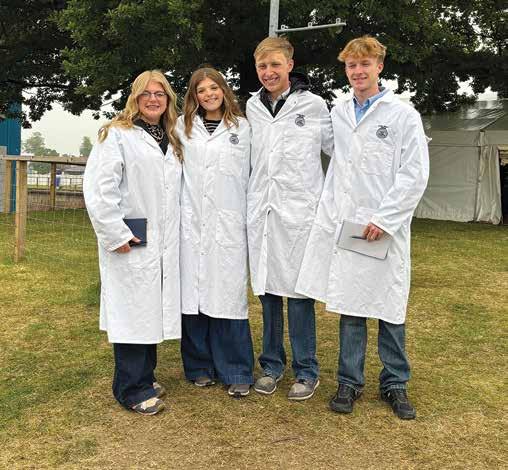
before,” he said.
Heath also credited the generous community for making the trip possible.
“I want to compliment our community,” he stated. “We had to fundraise to get our kids there, and all of the money was either contributed by the families or fundraised. We held several events, and we were able to fundraise for the kids completely so they didn’t have any out-of-pocket expense. I think this speaks so highly of our community.”
The team returned home from their once-in-a-lifetime trip on July 1, just in time for the Central Wyoming Fair, where all four students and their families are once again back in the
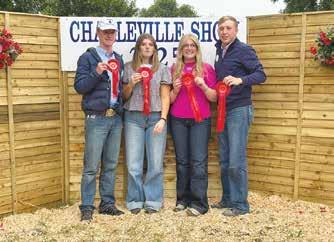
830#
Heiferette,
661#